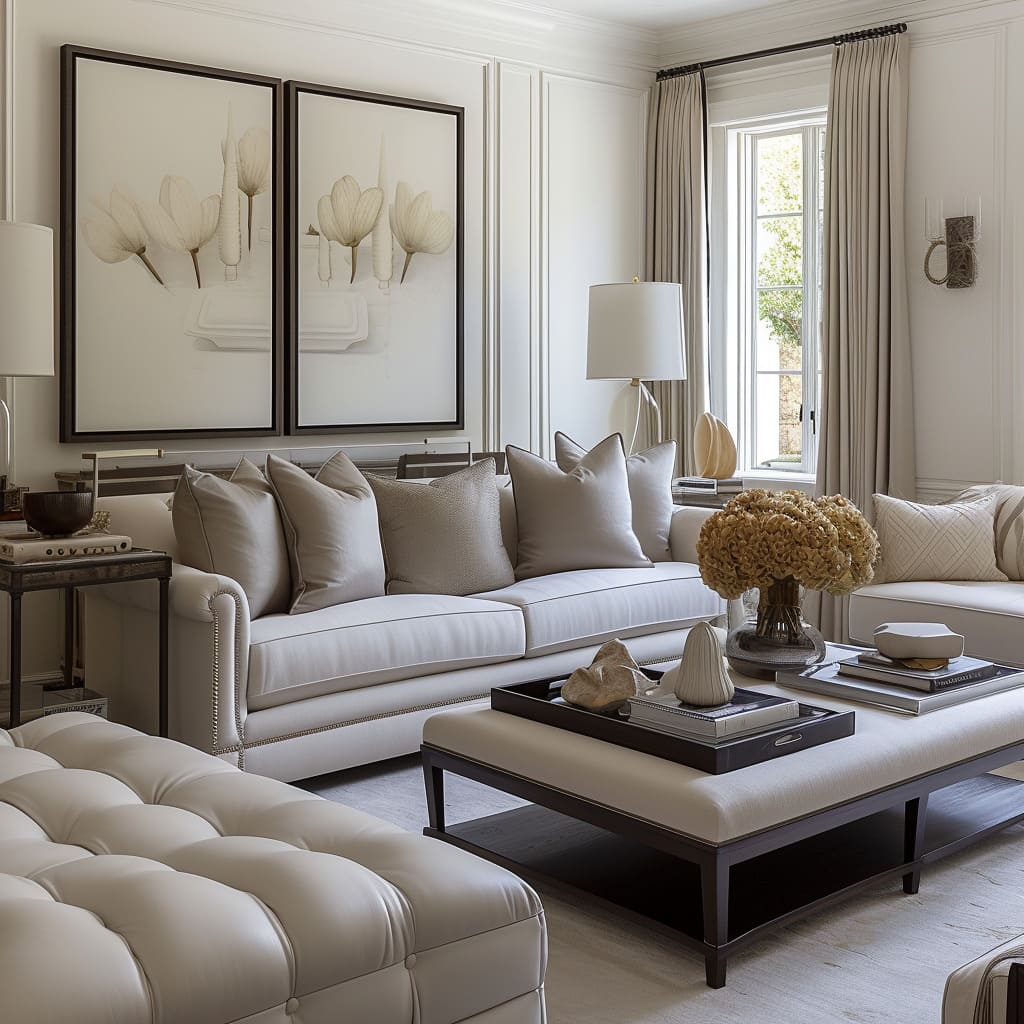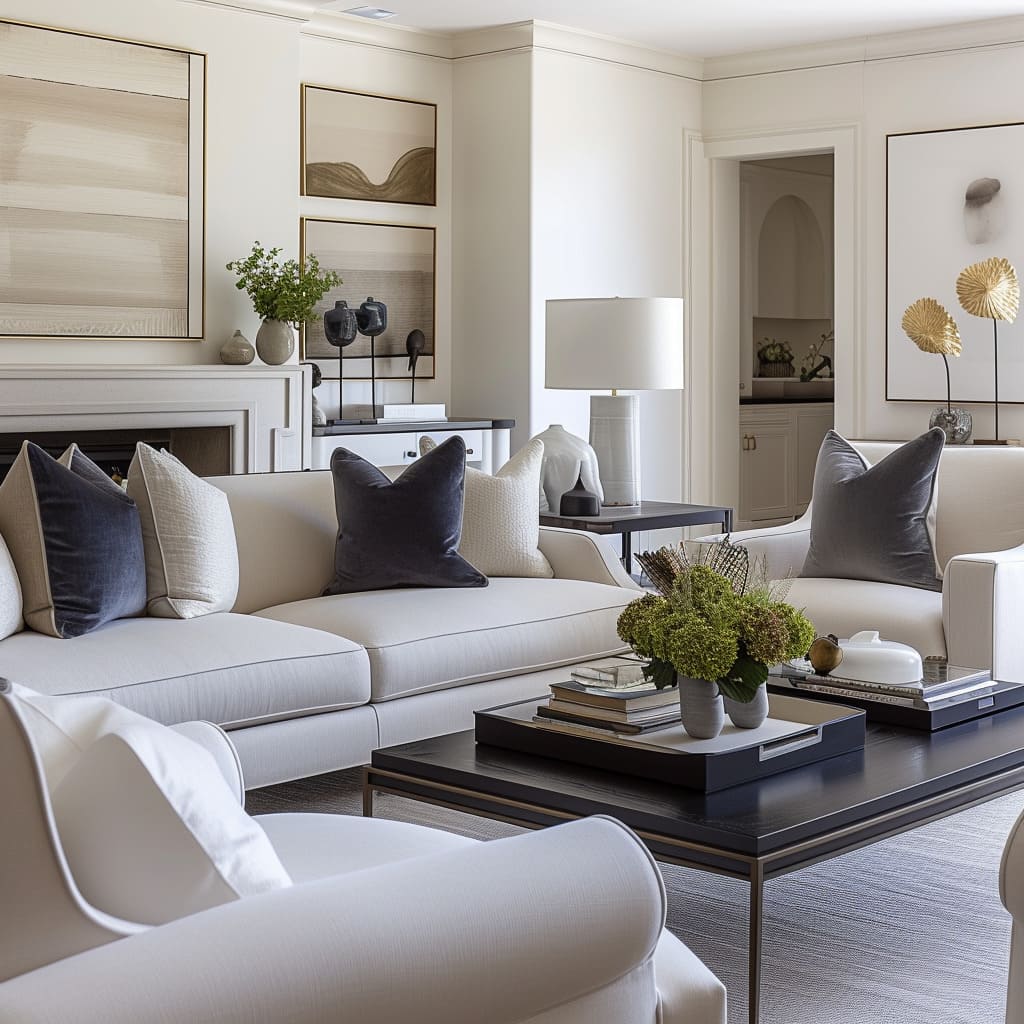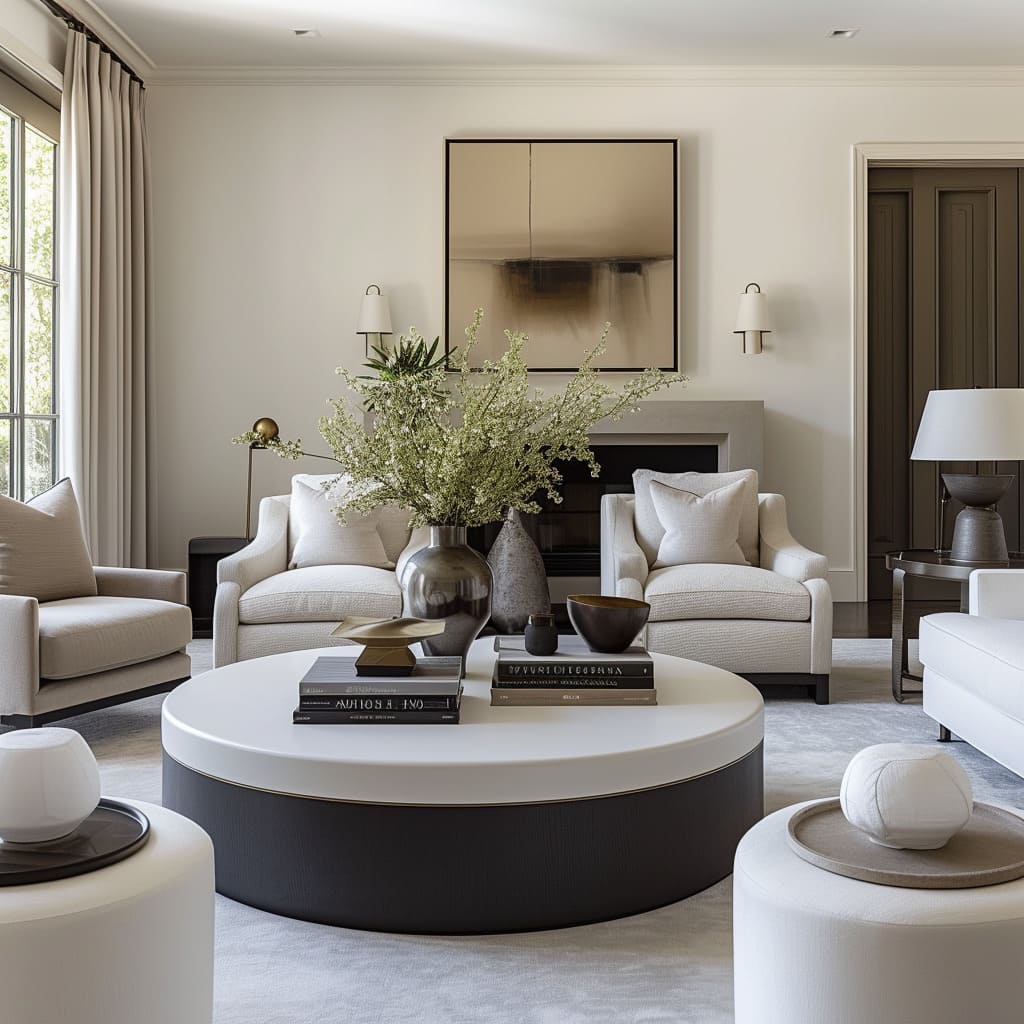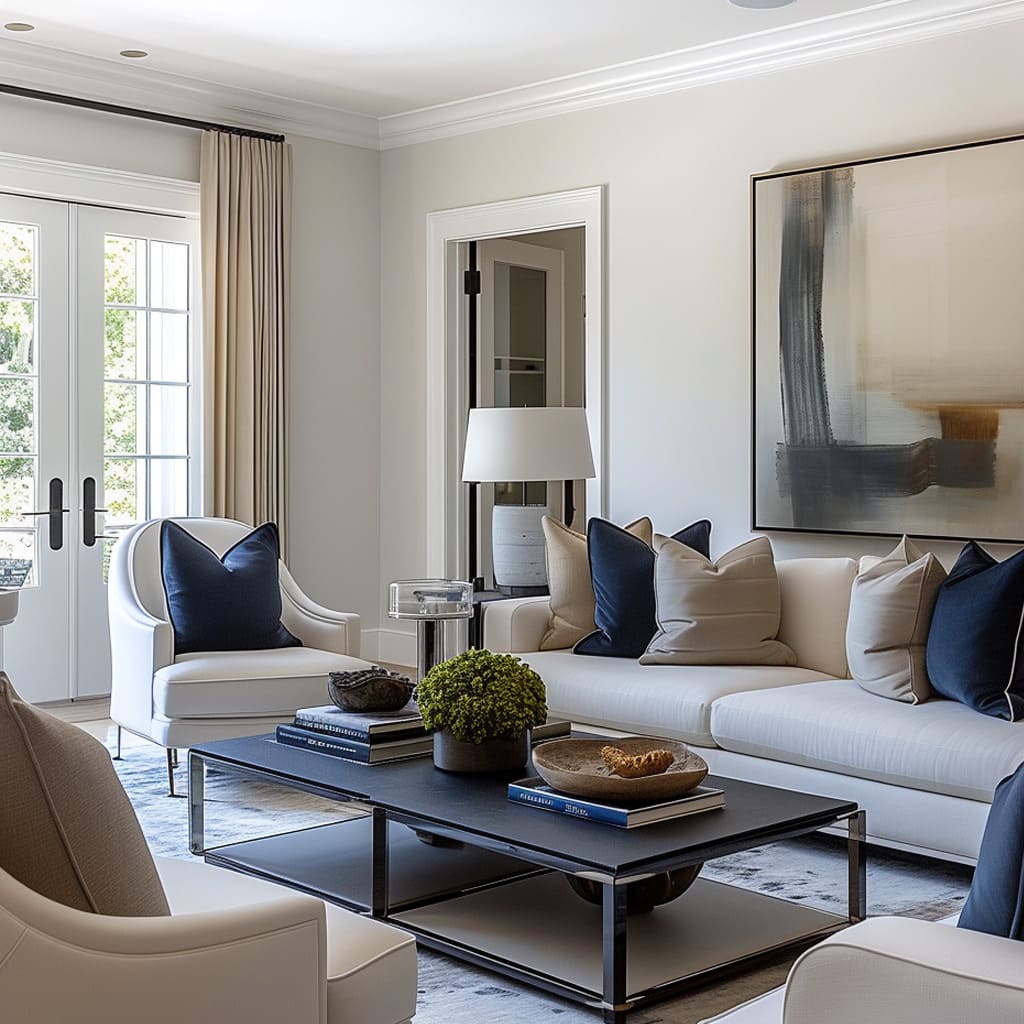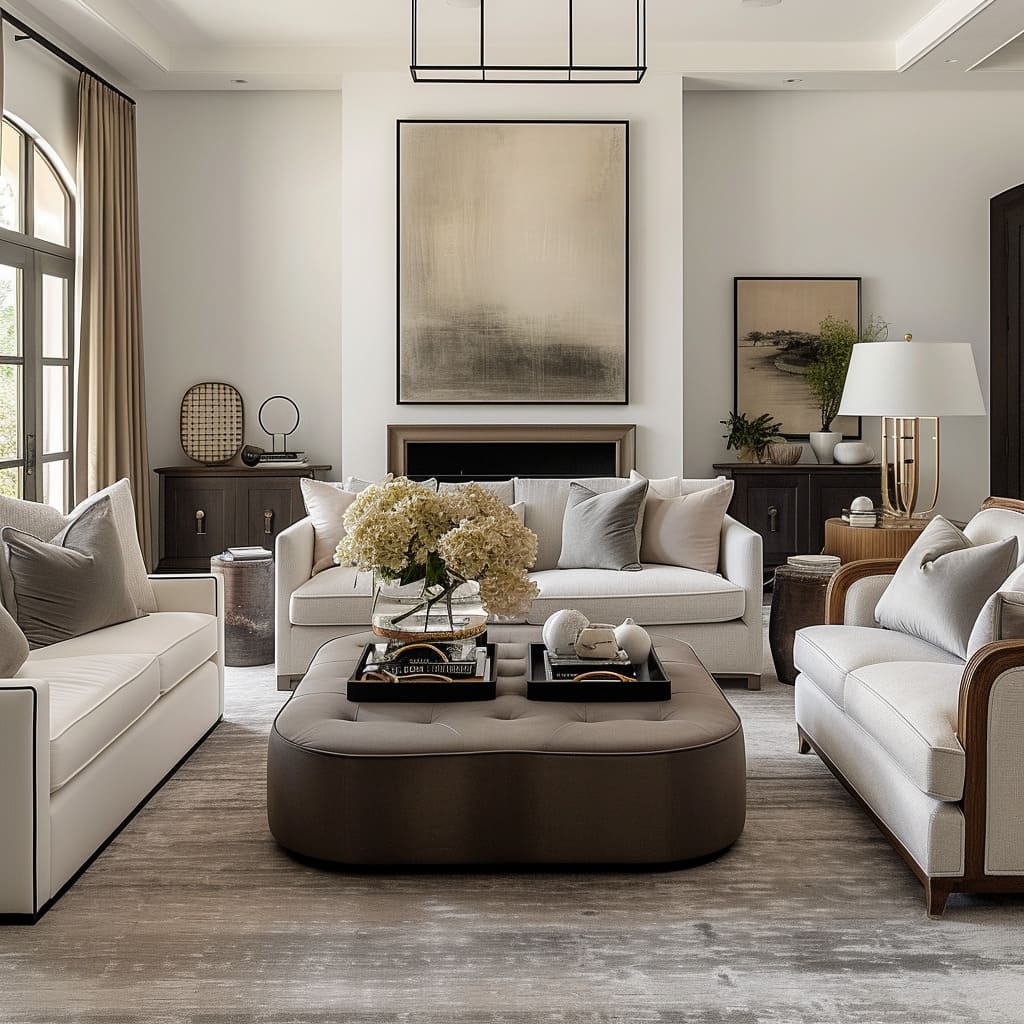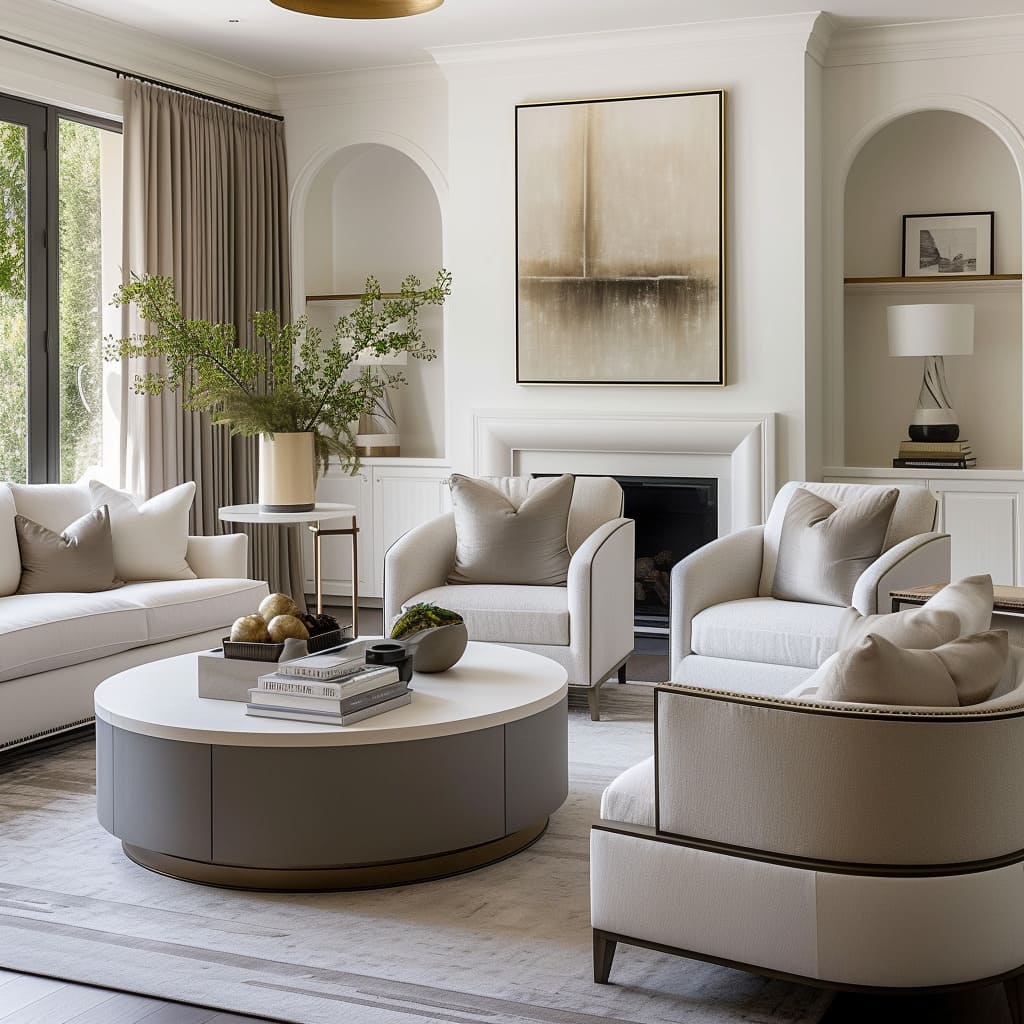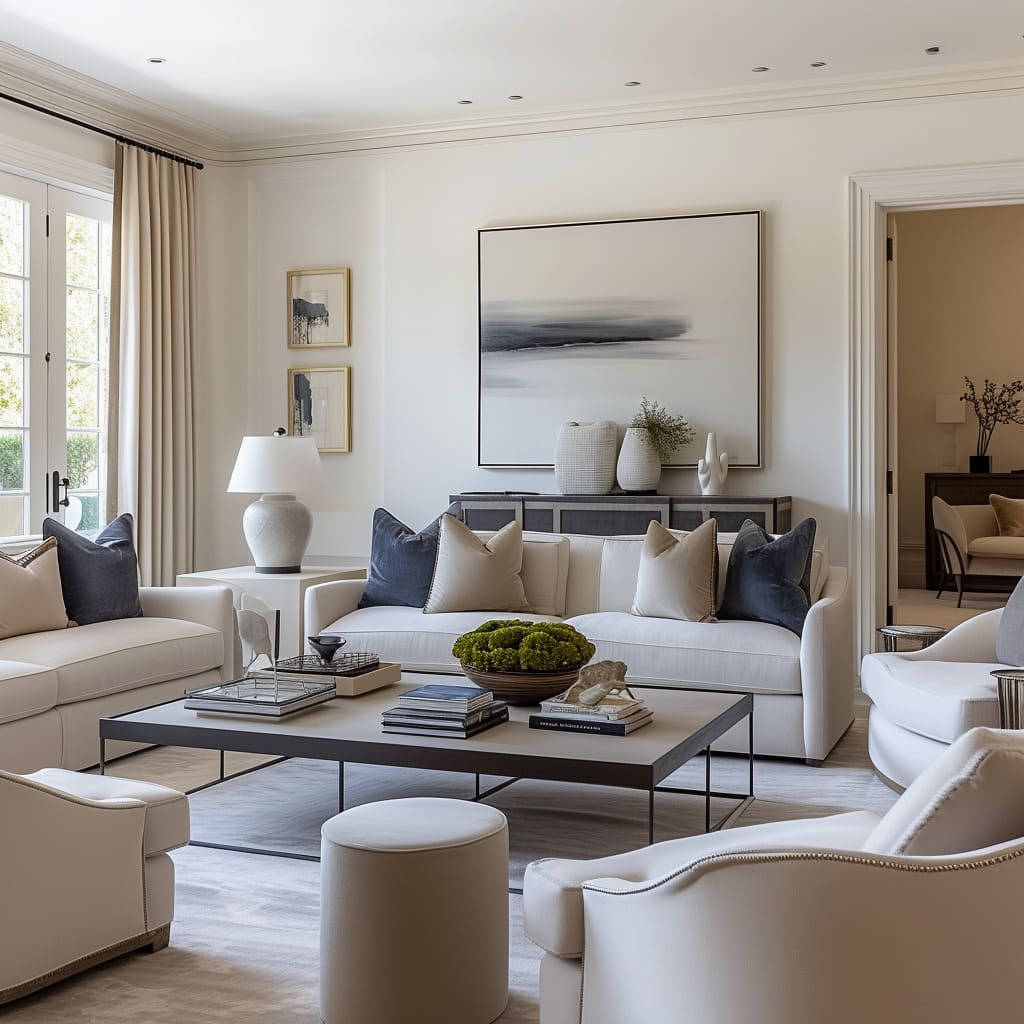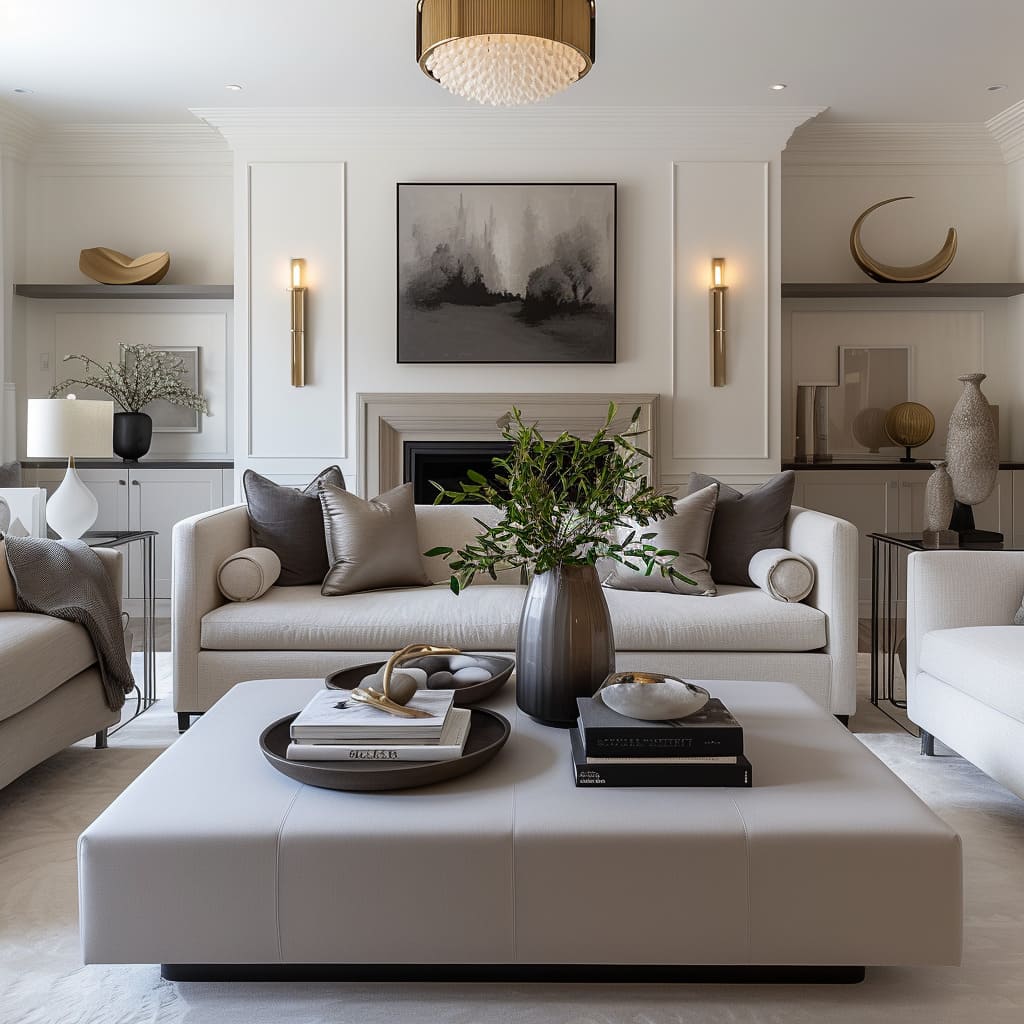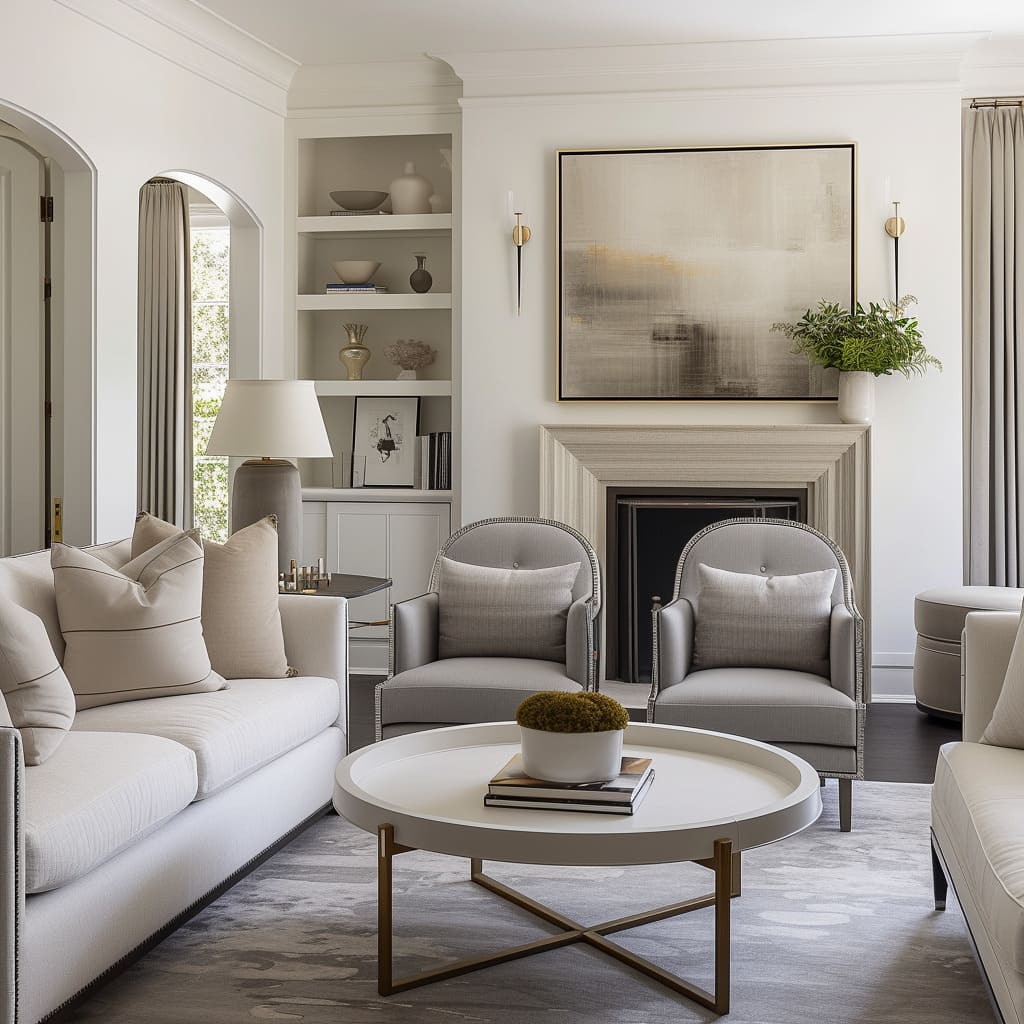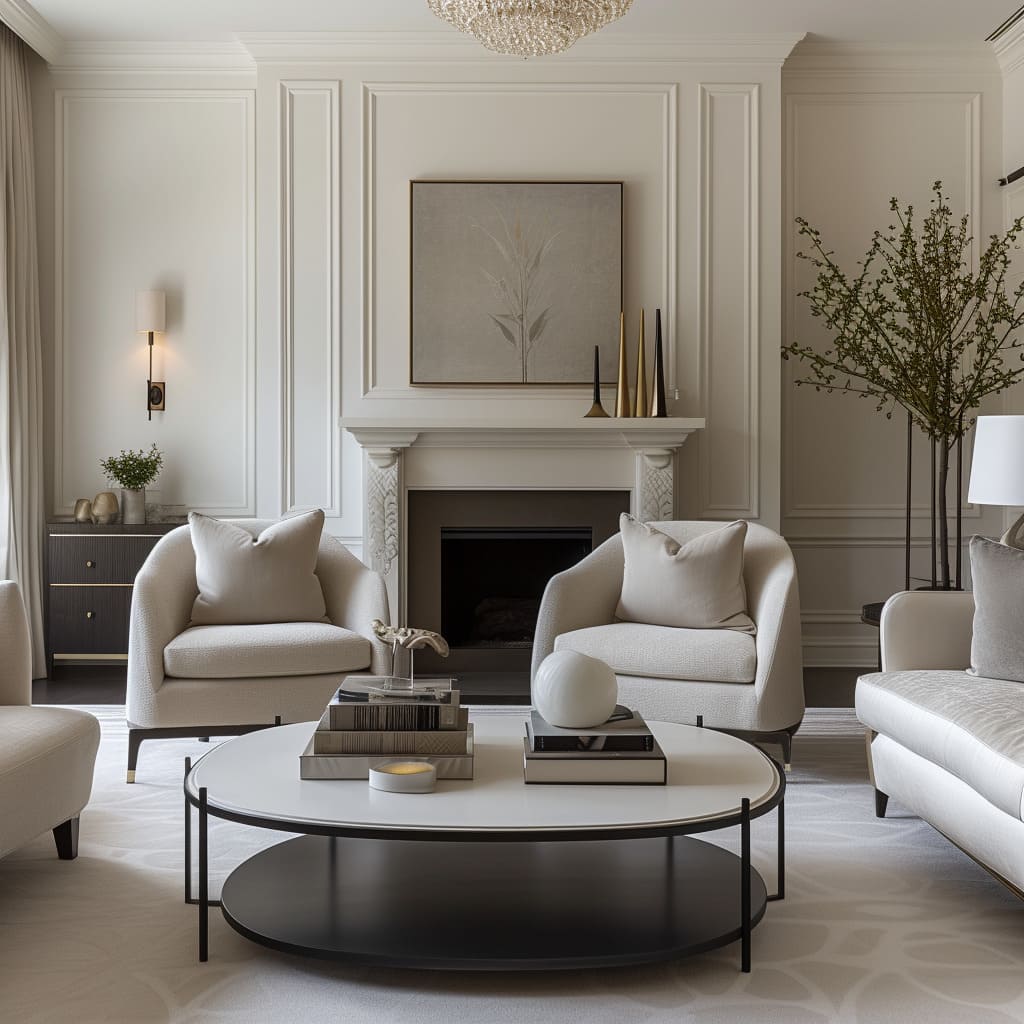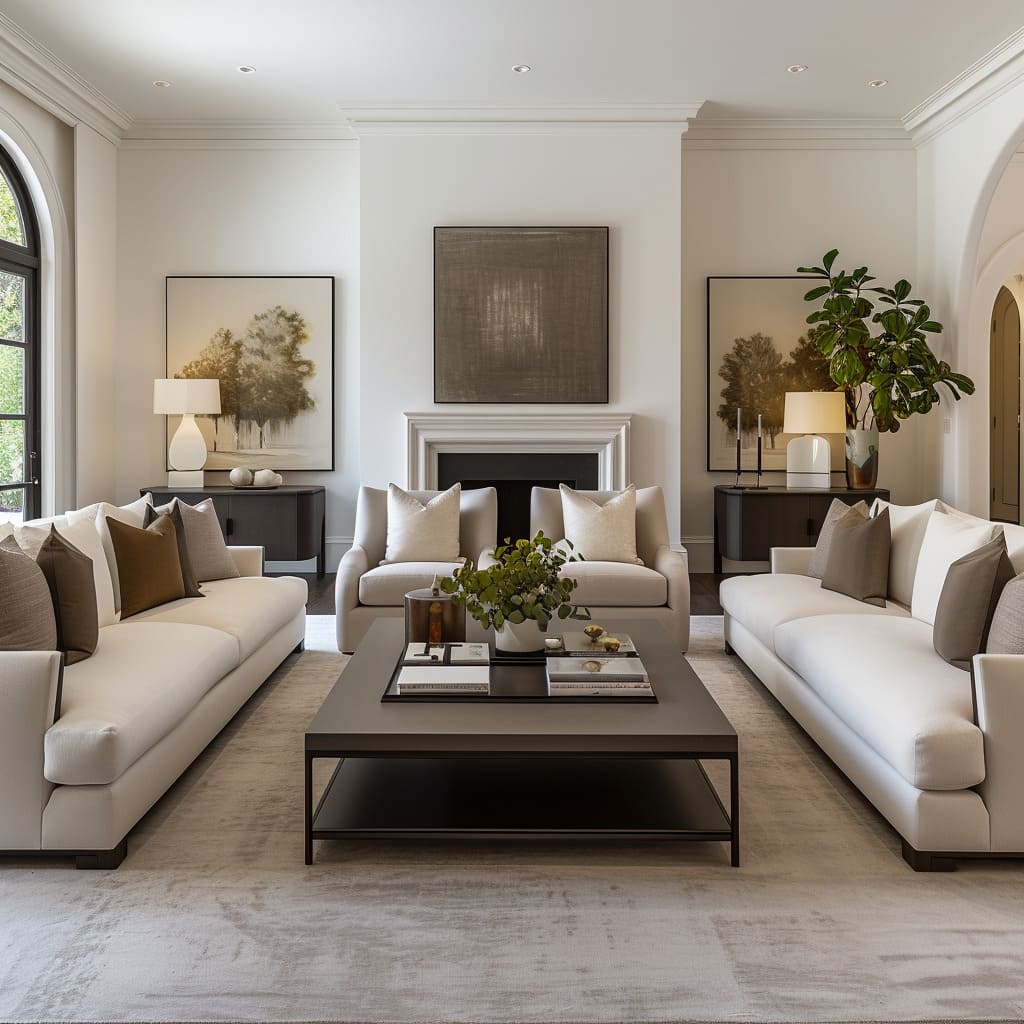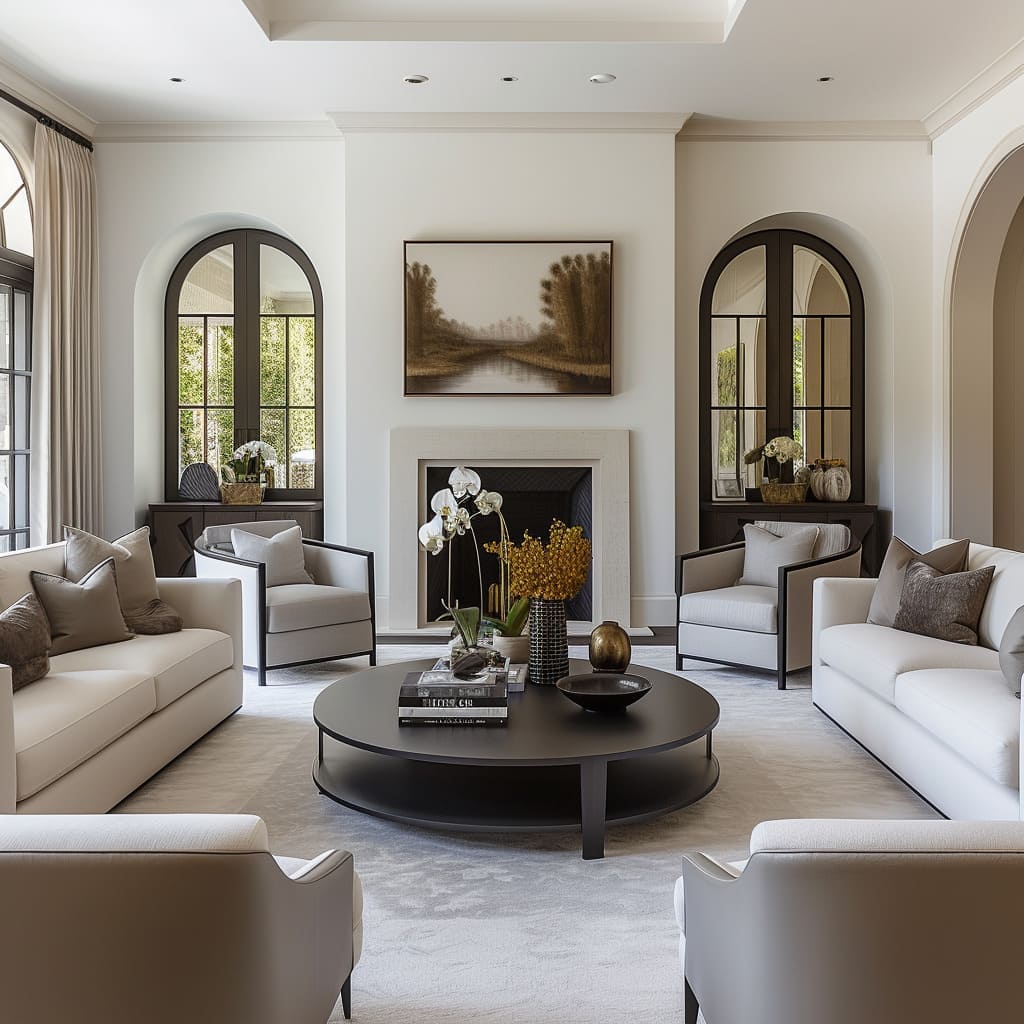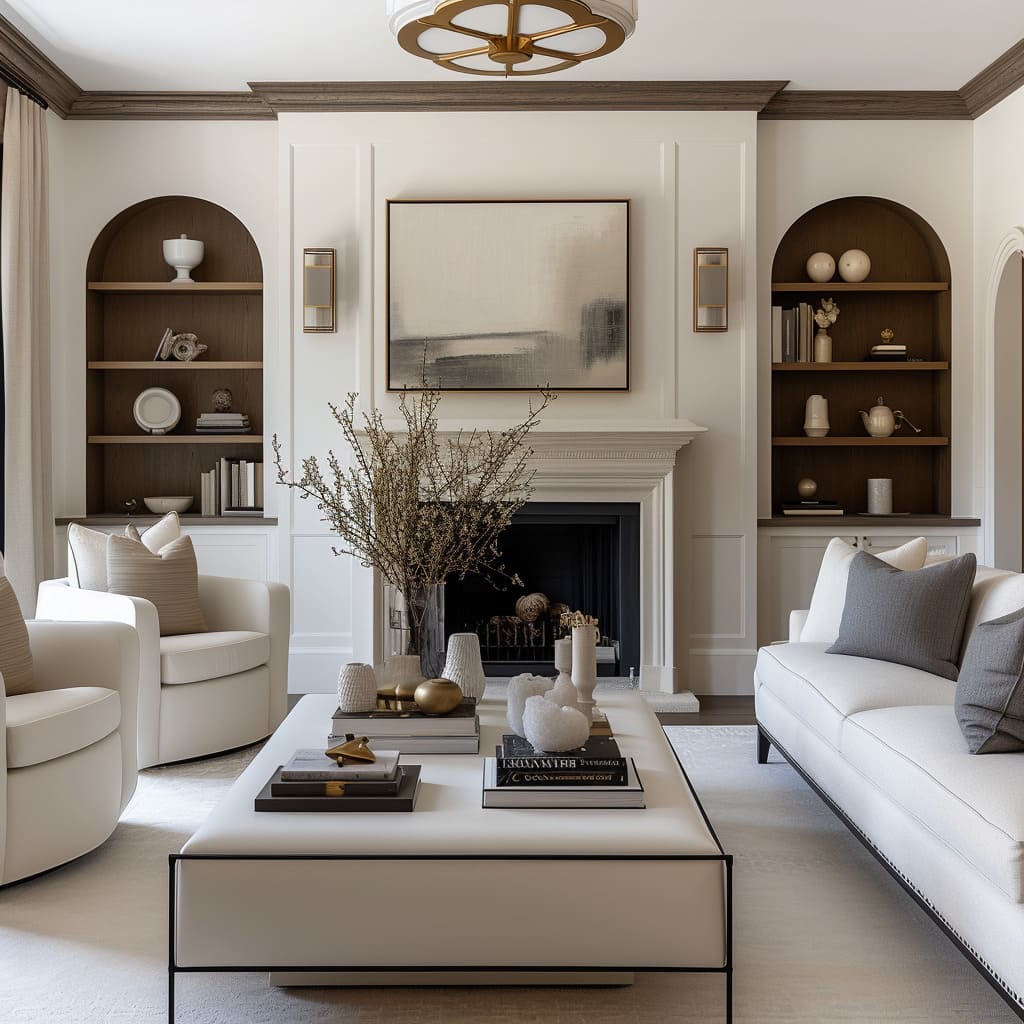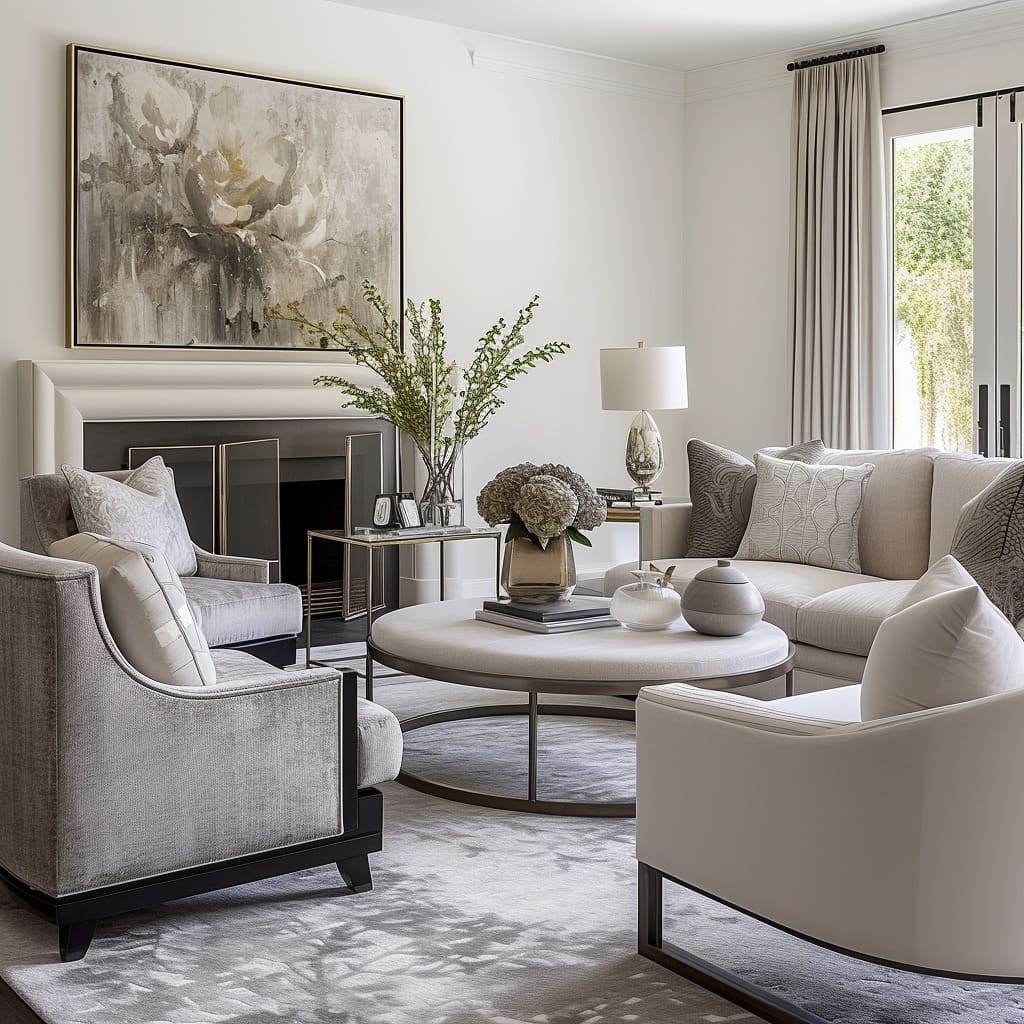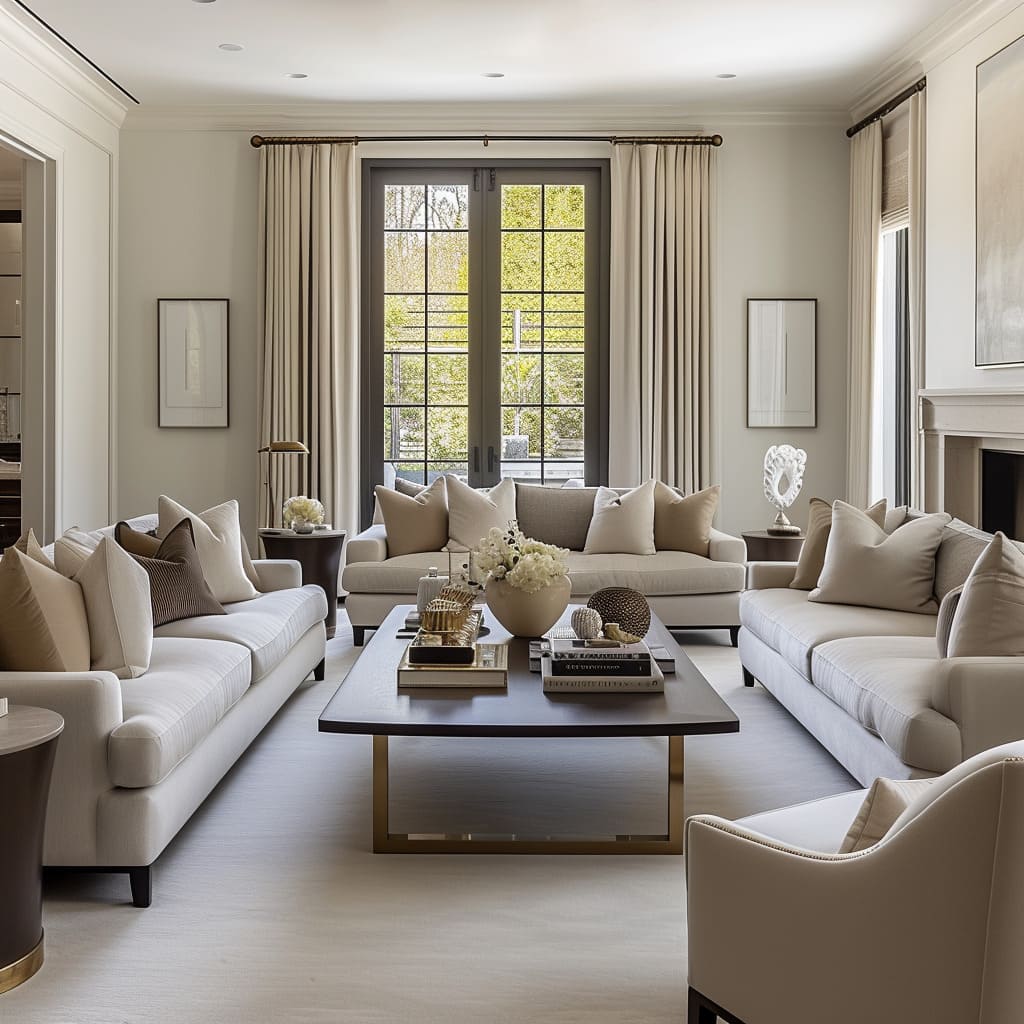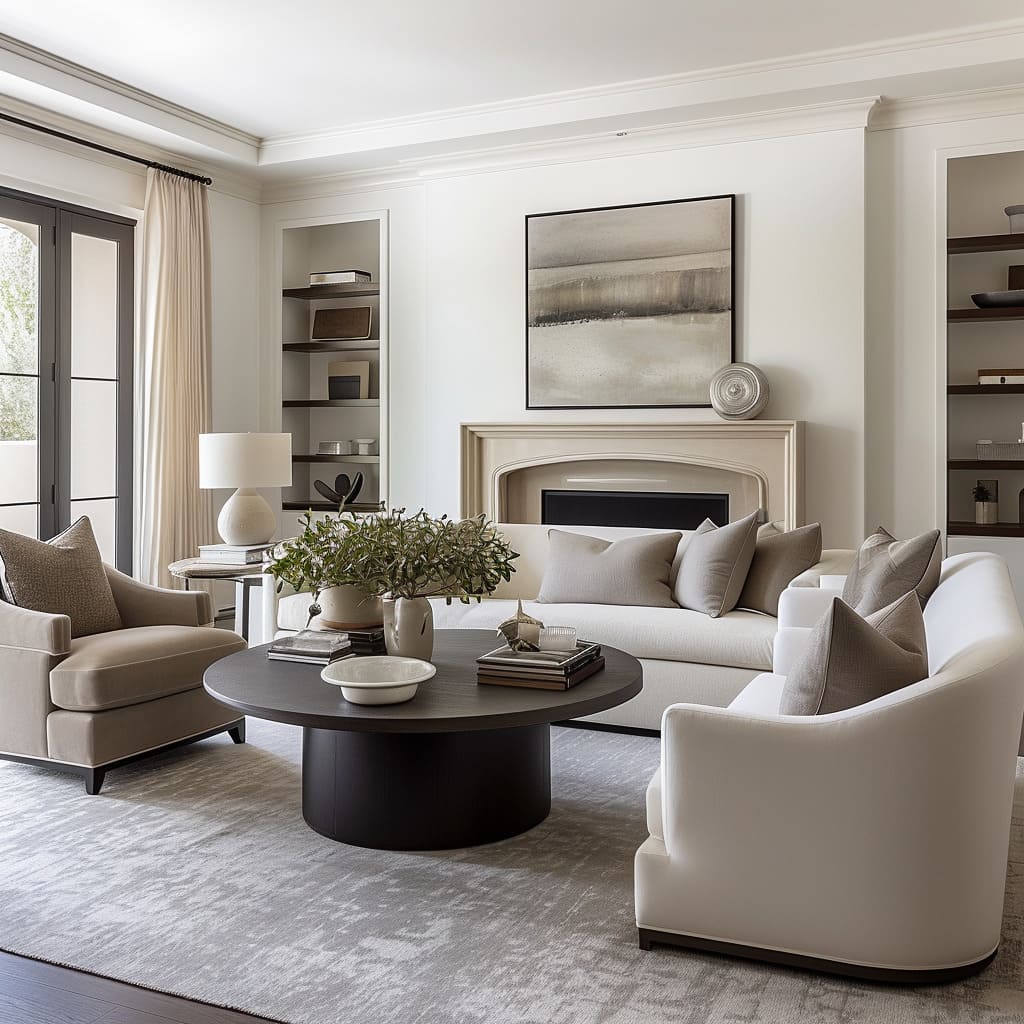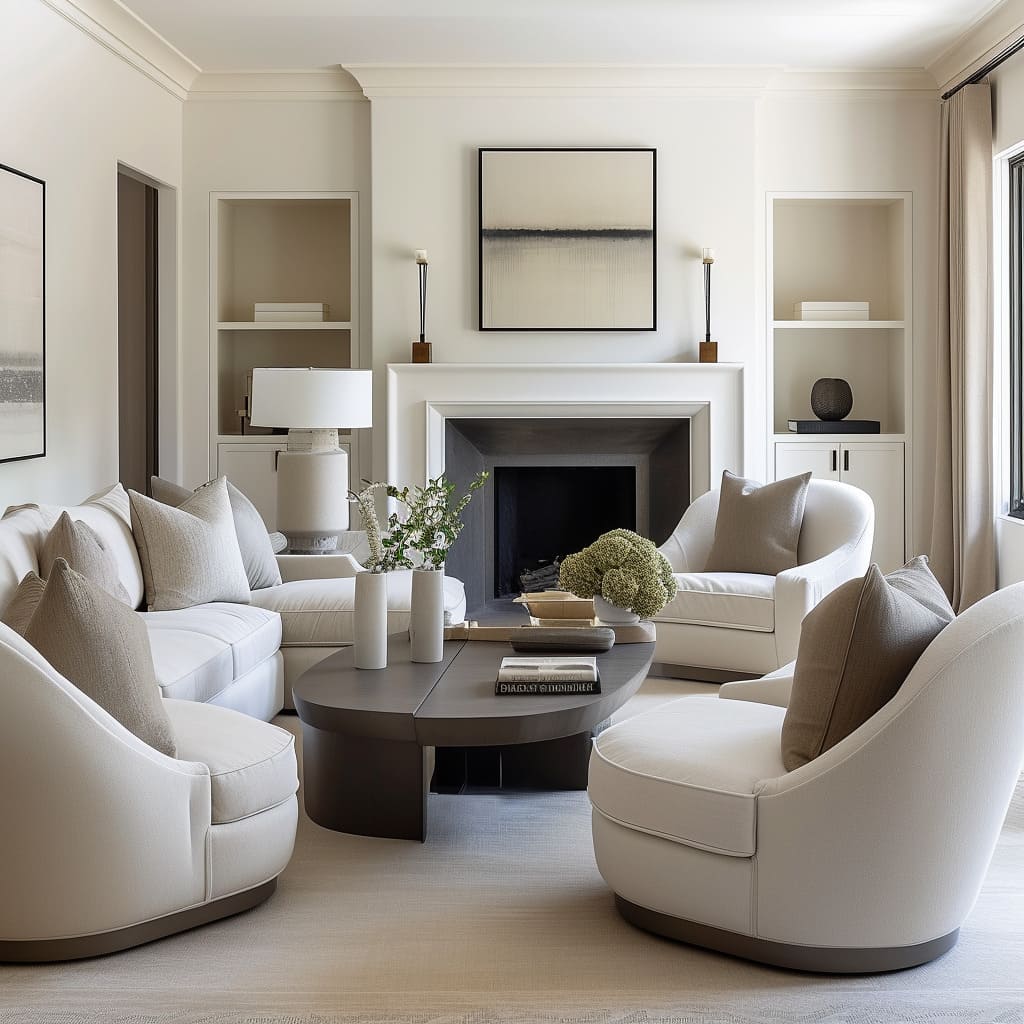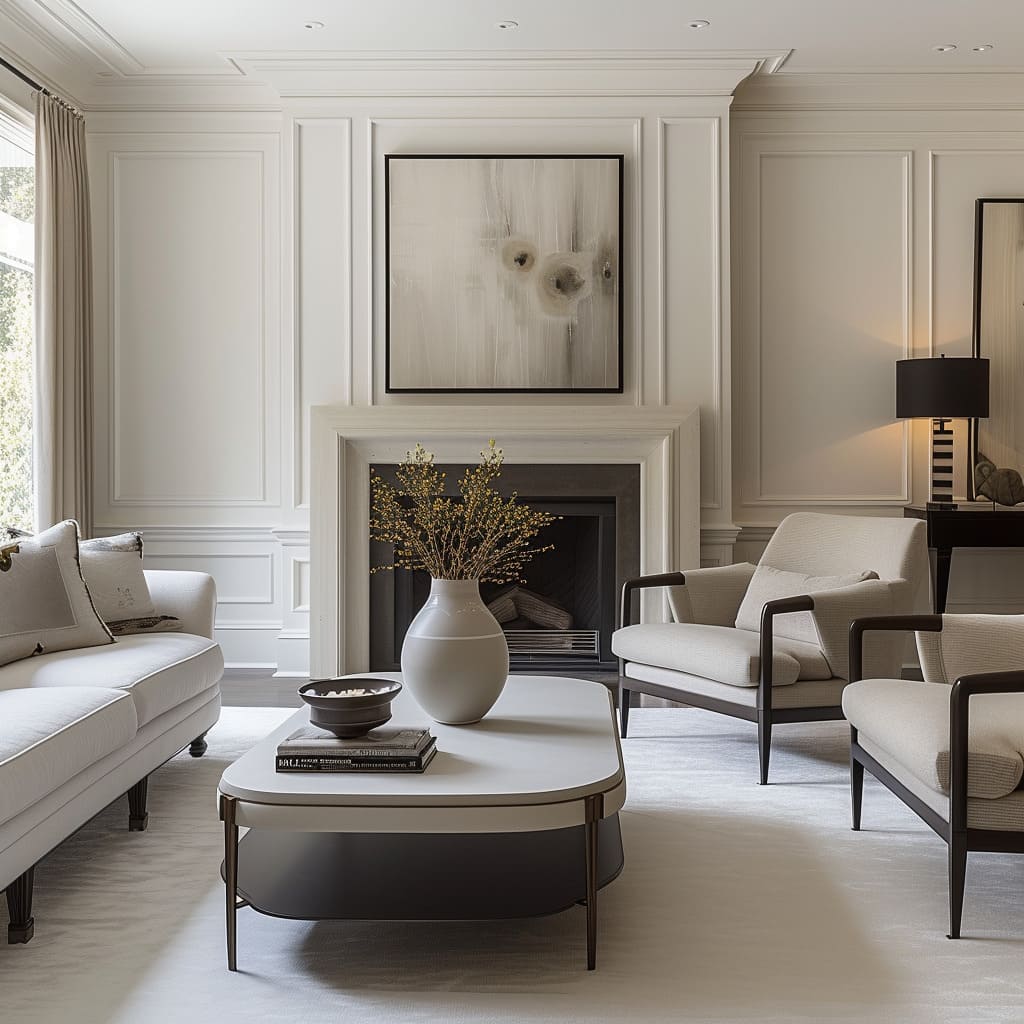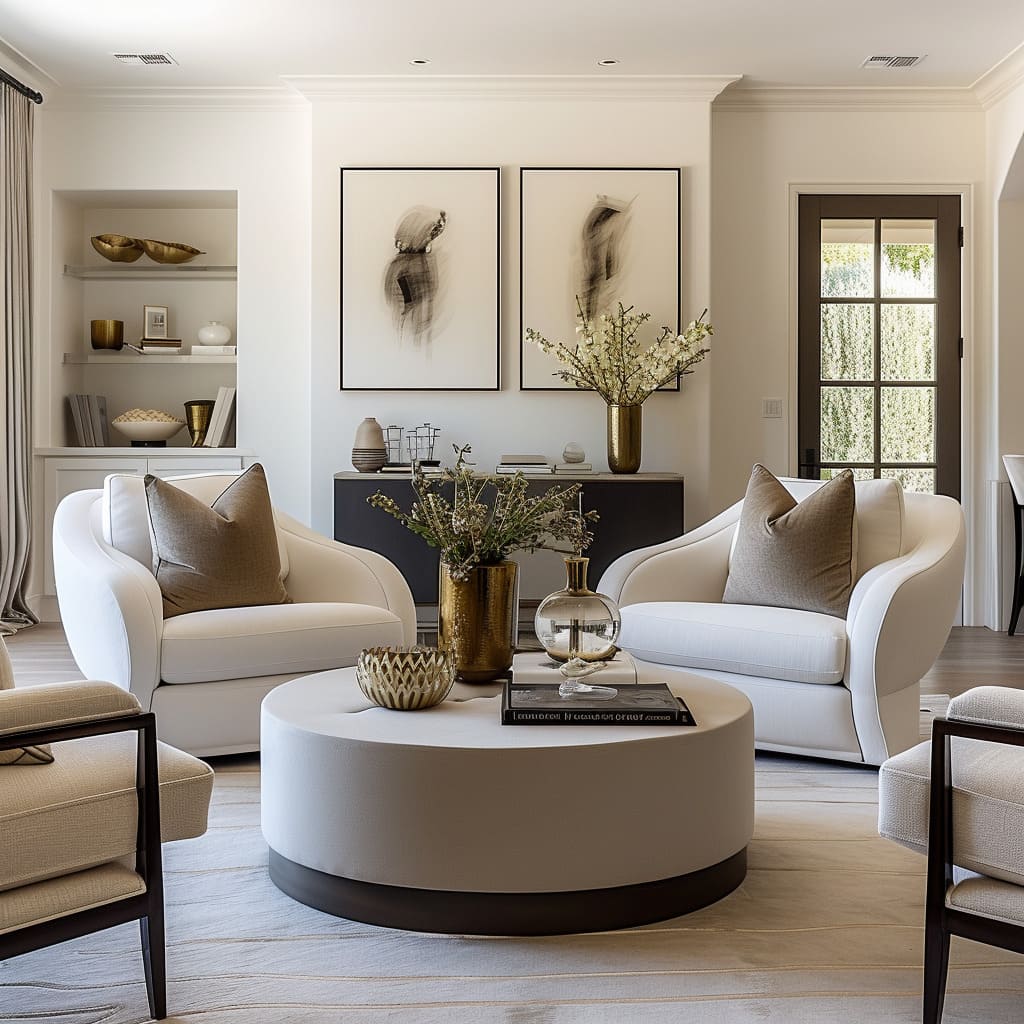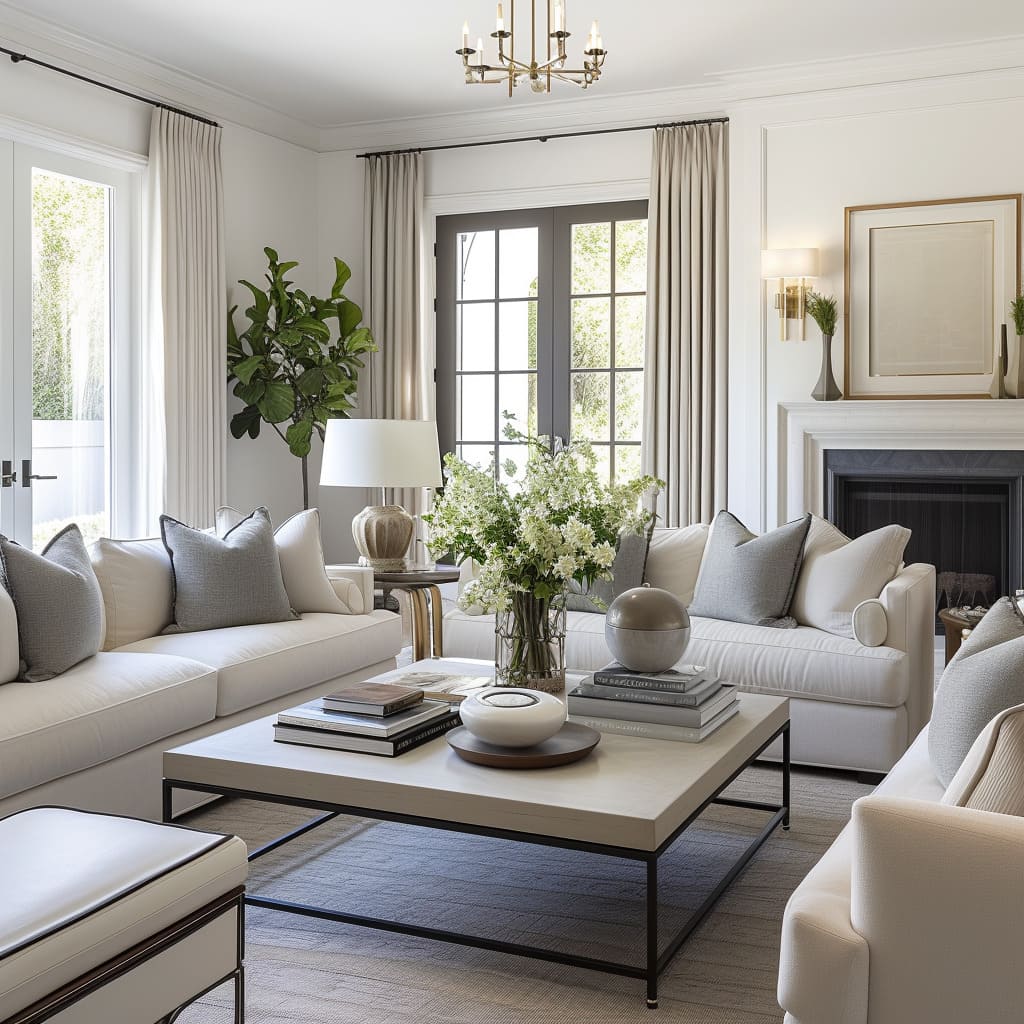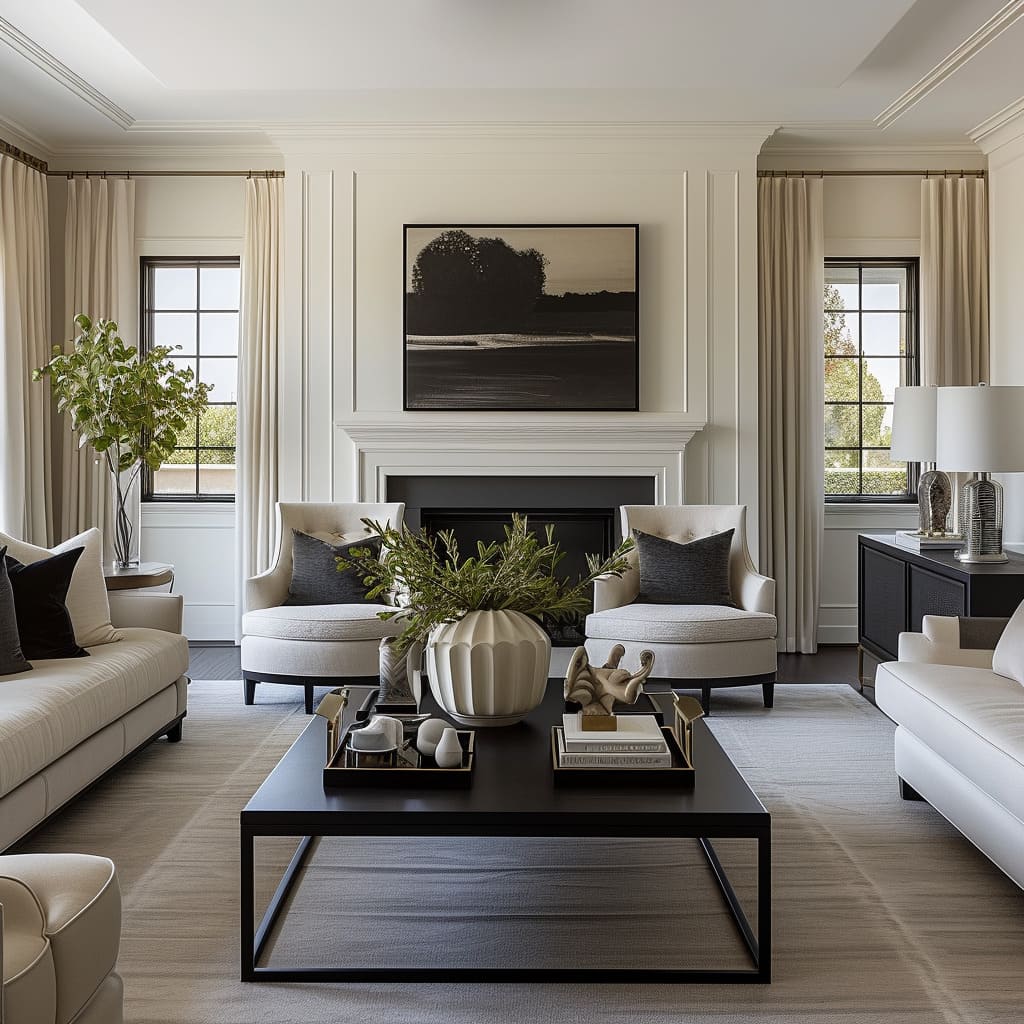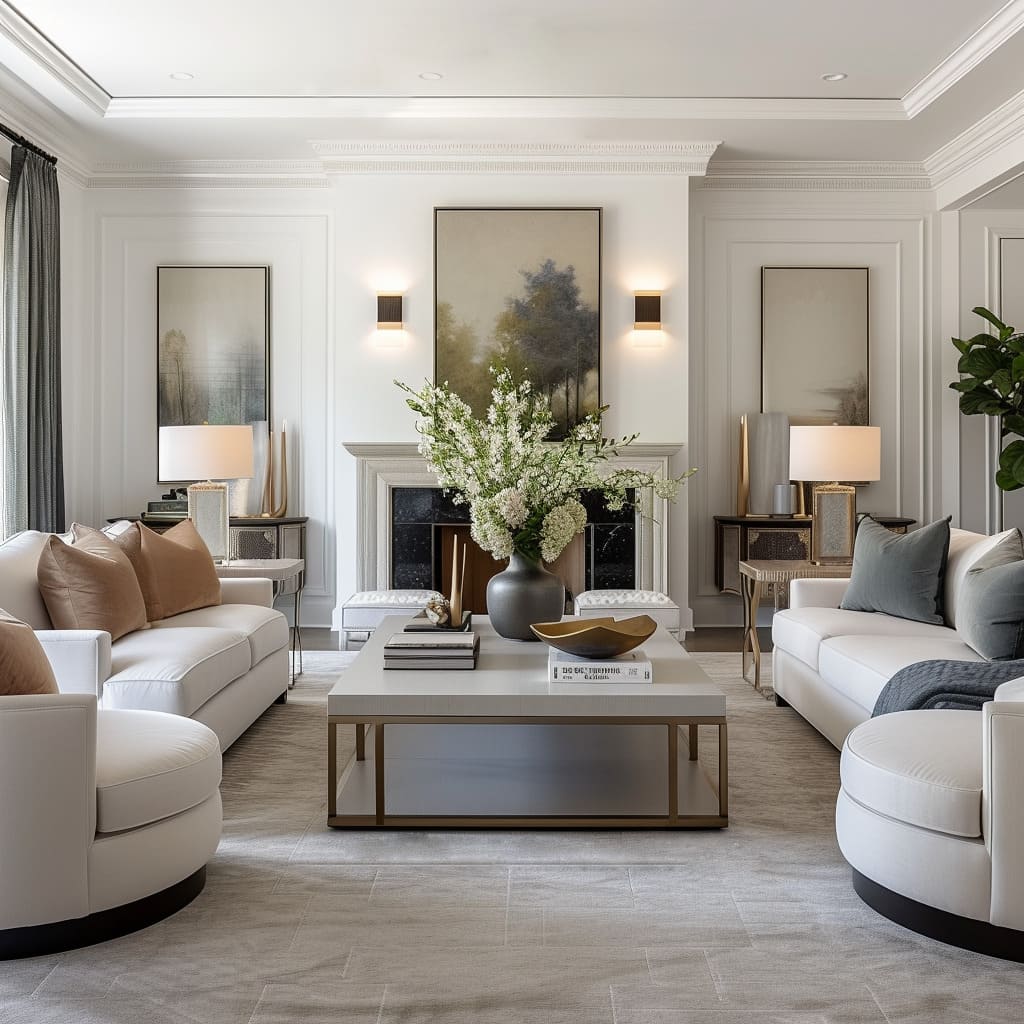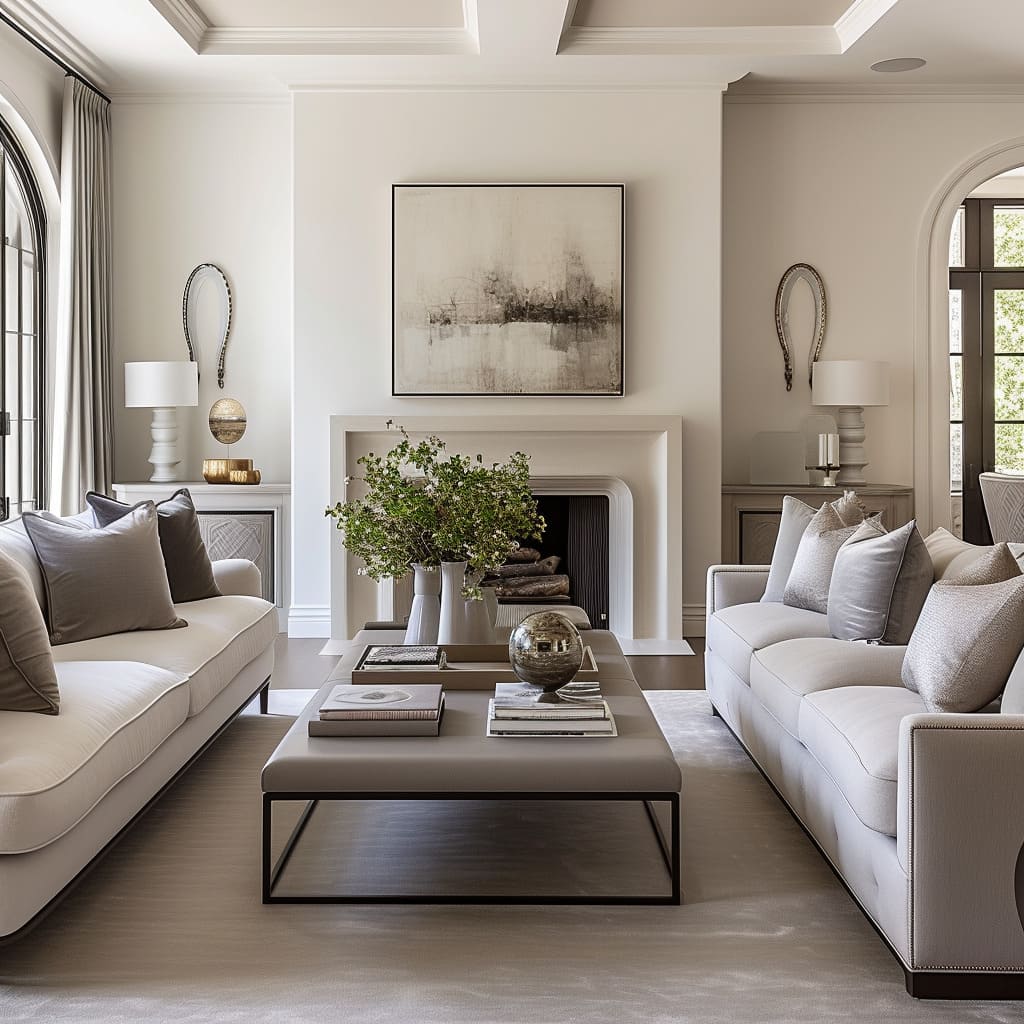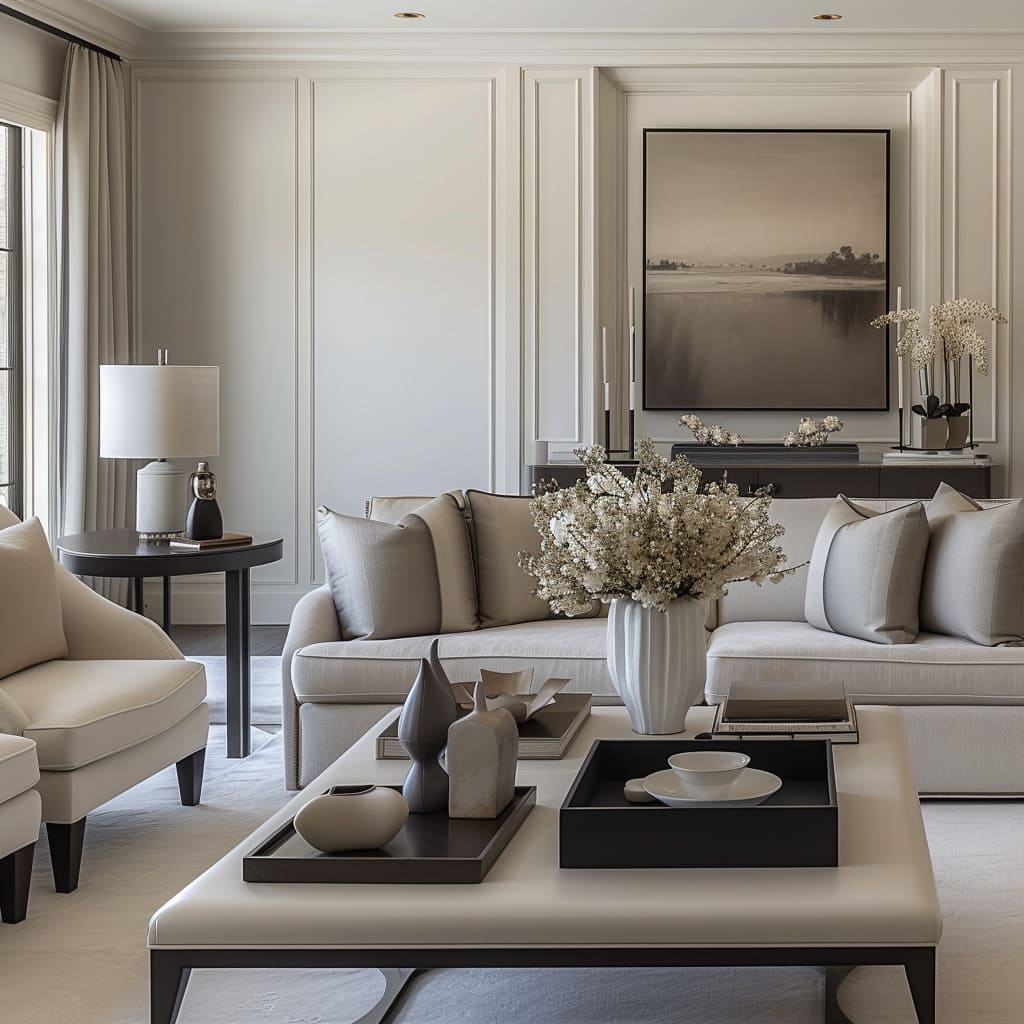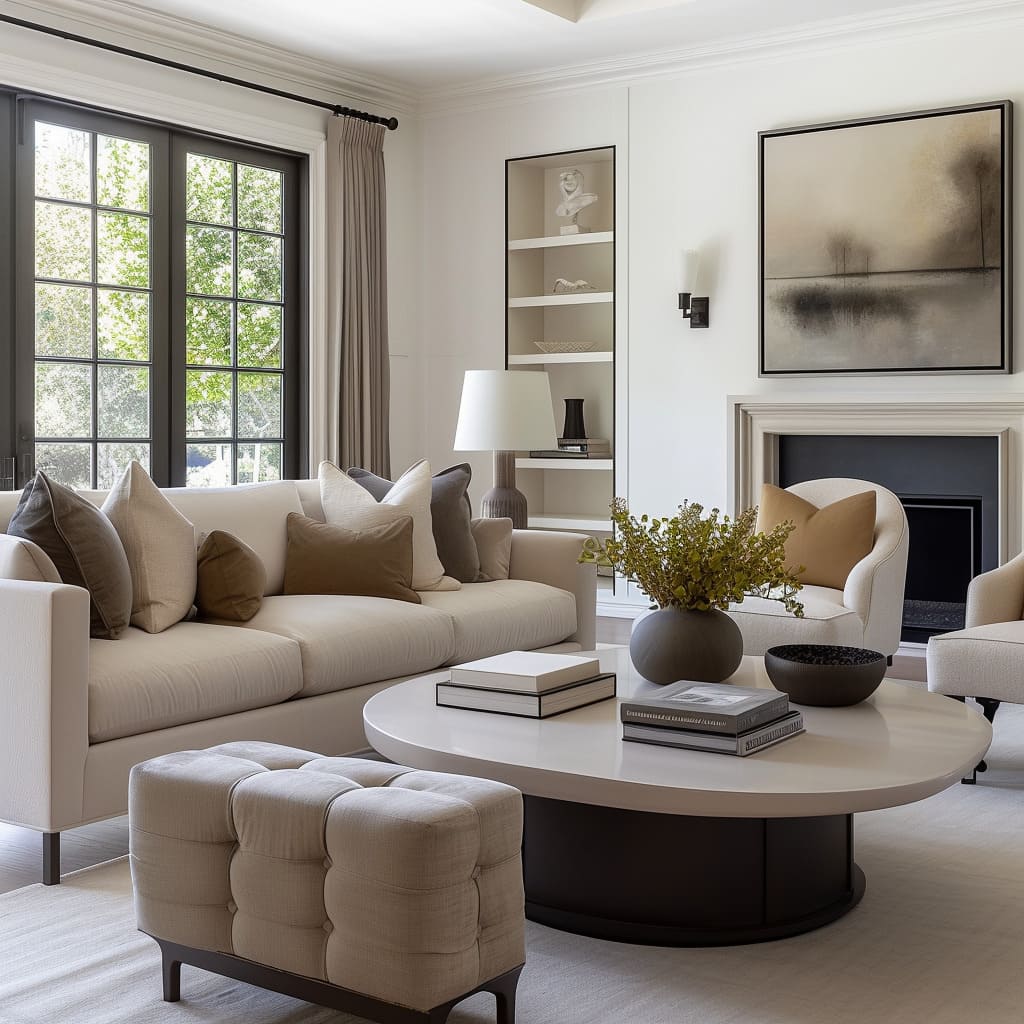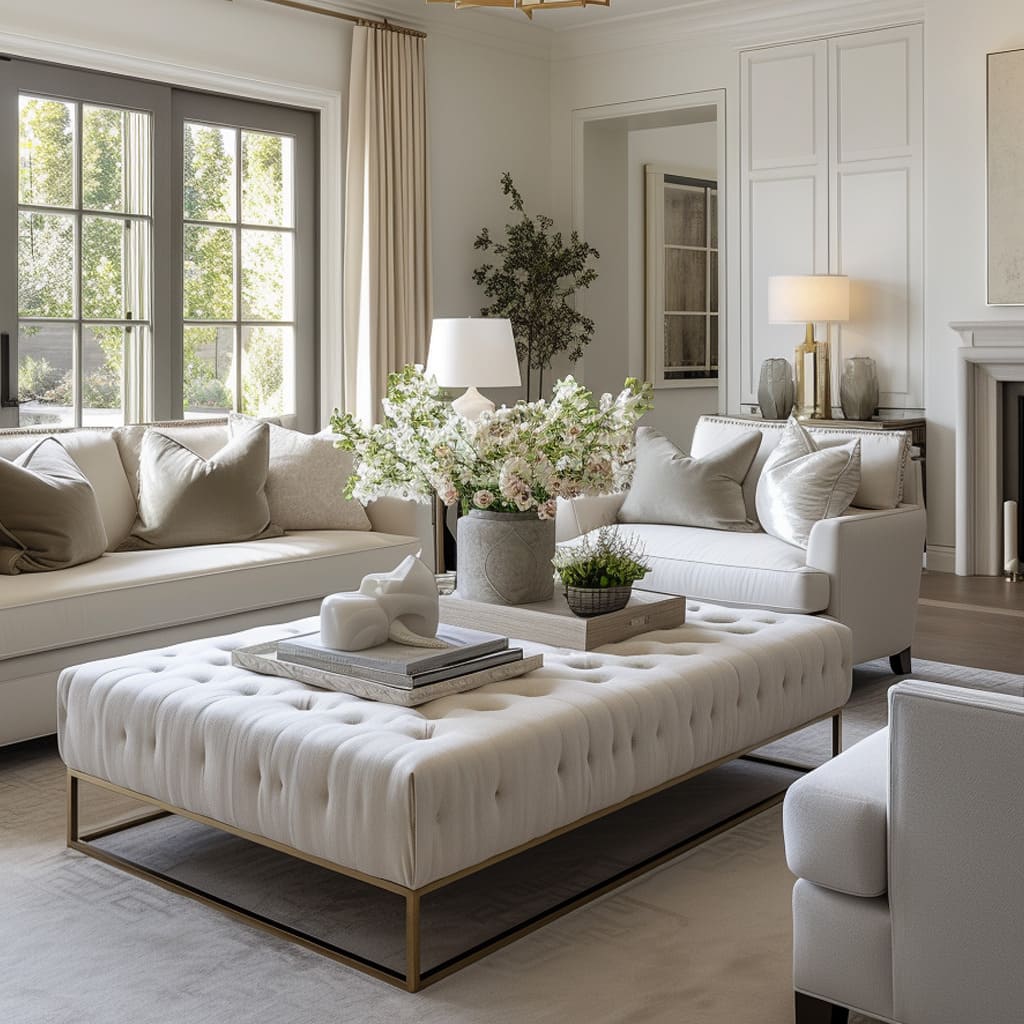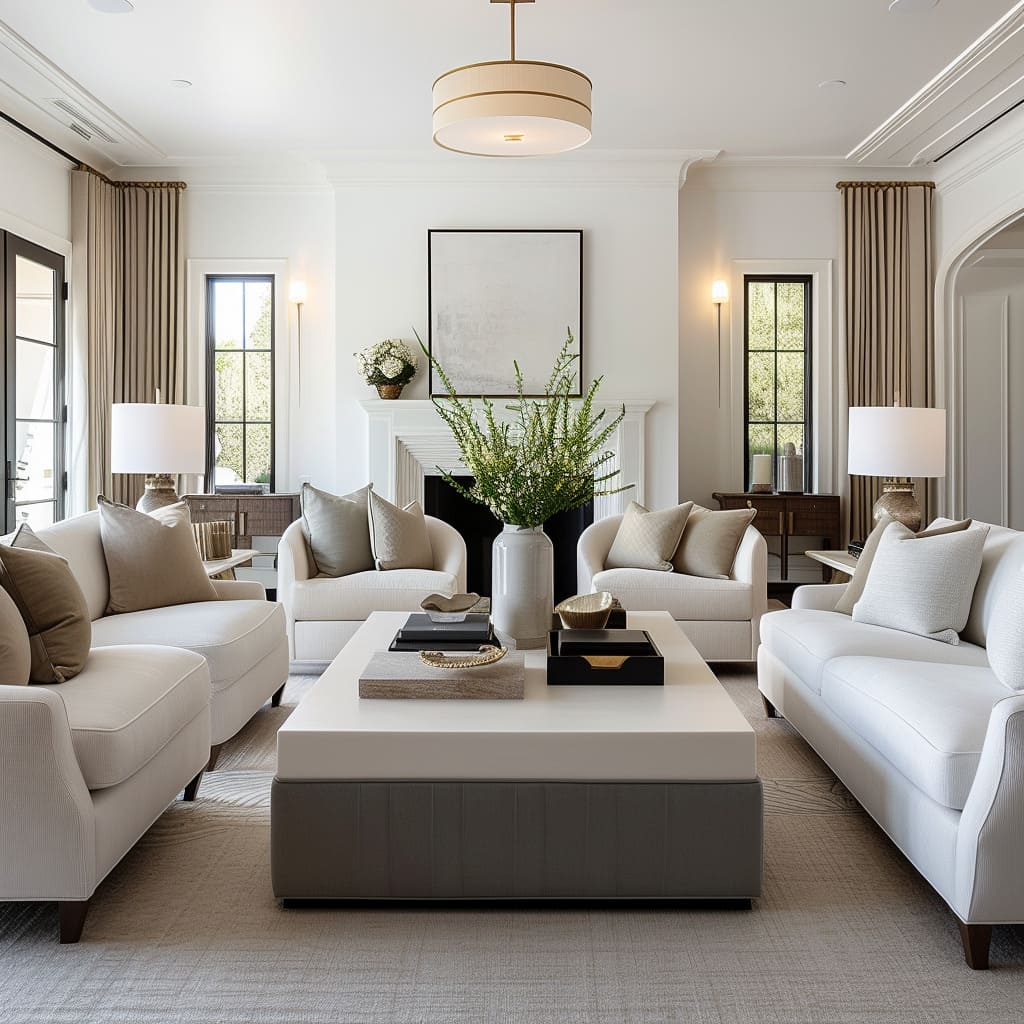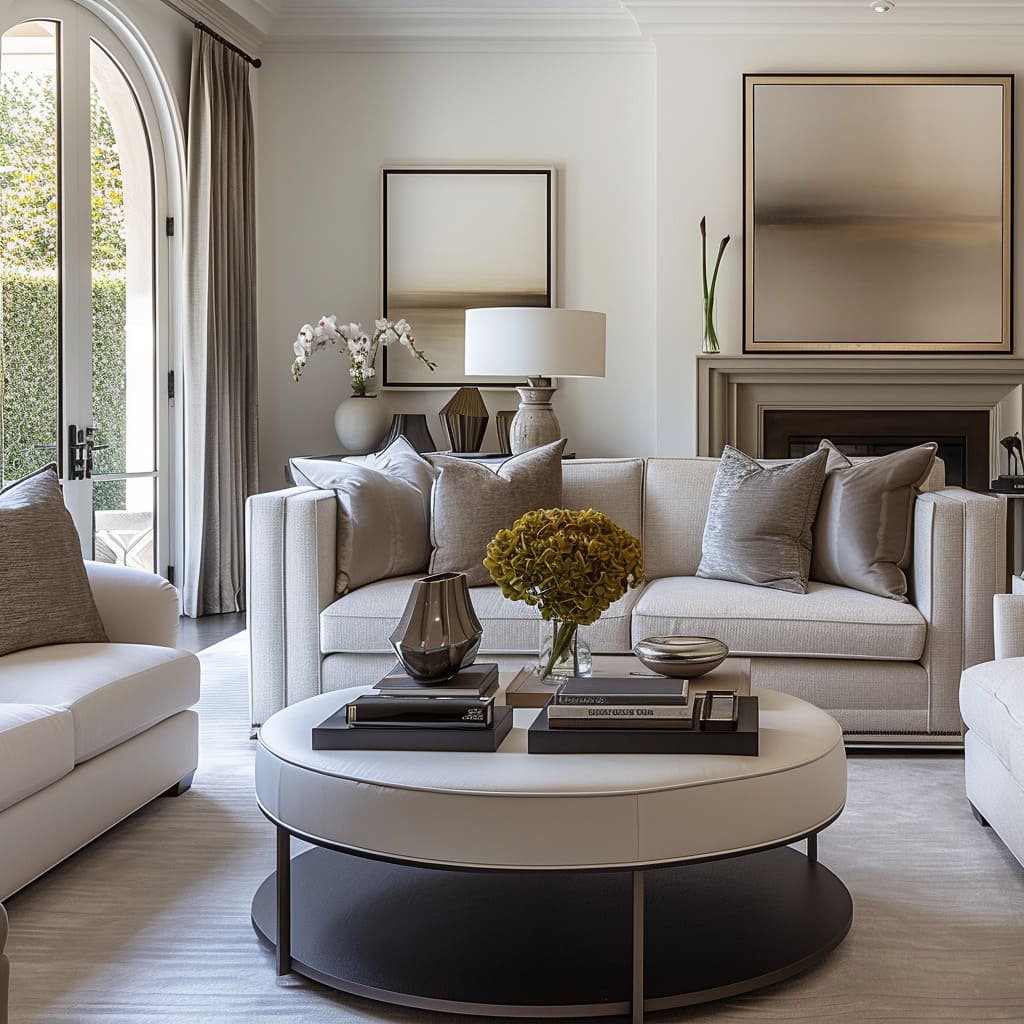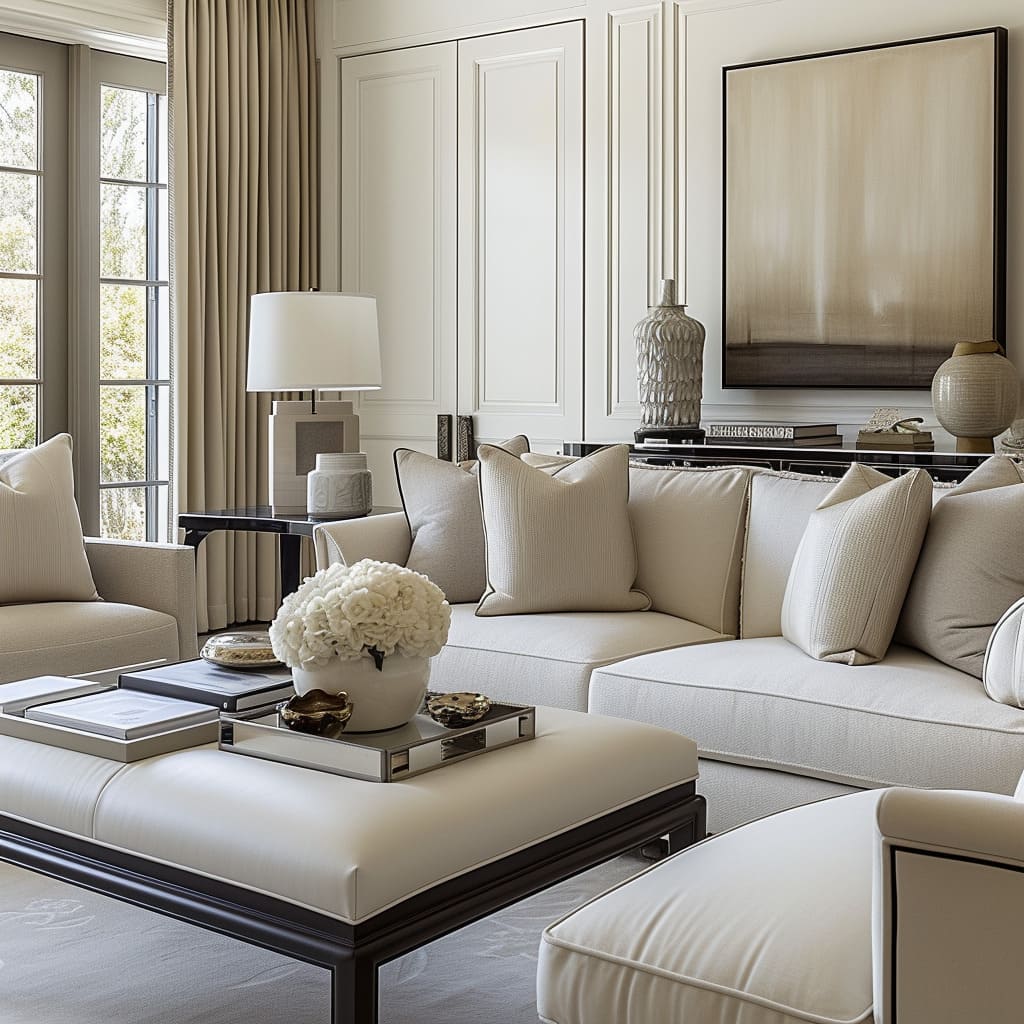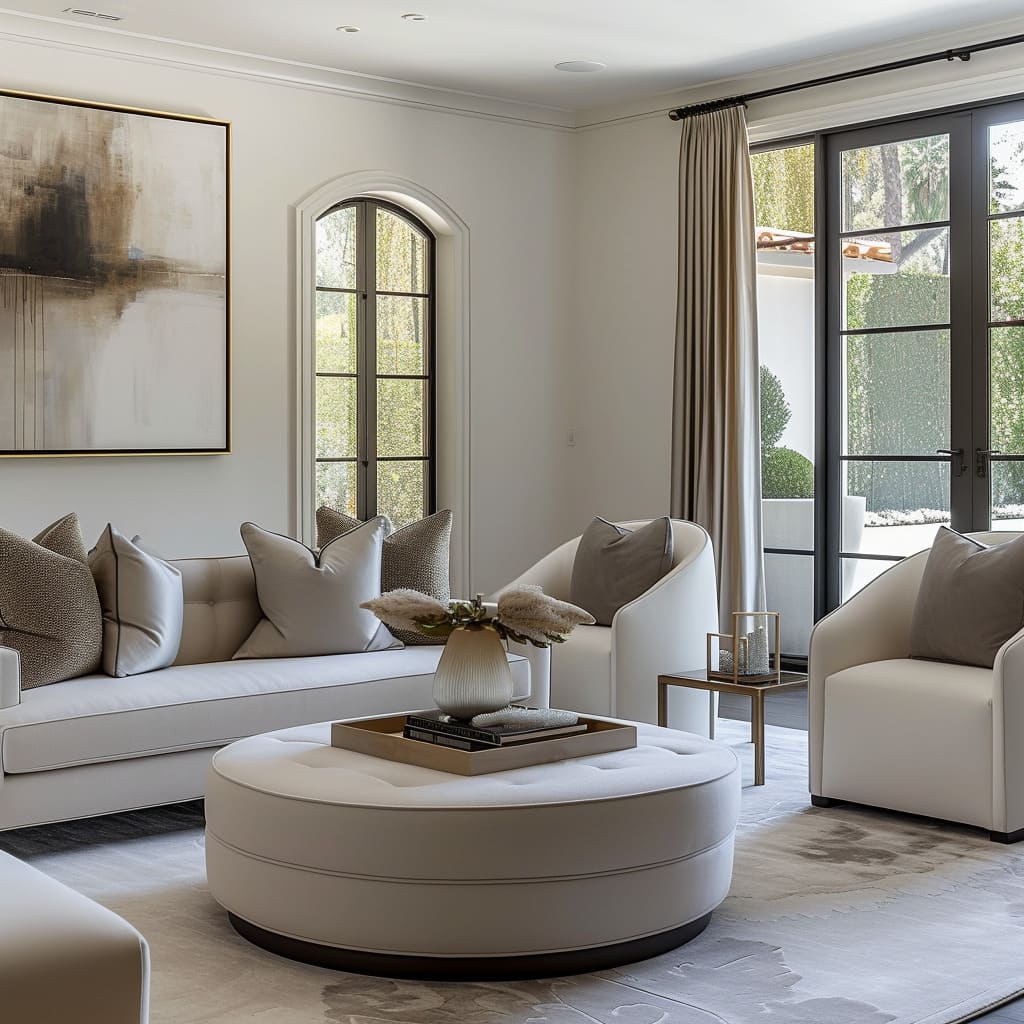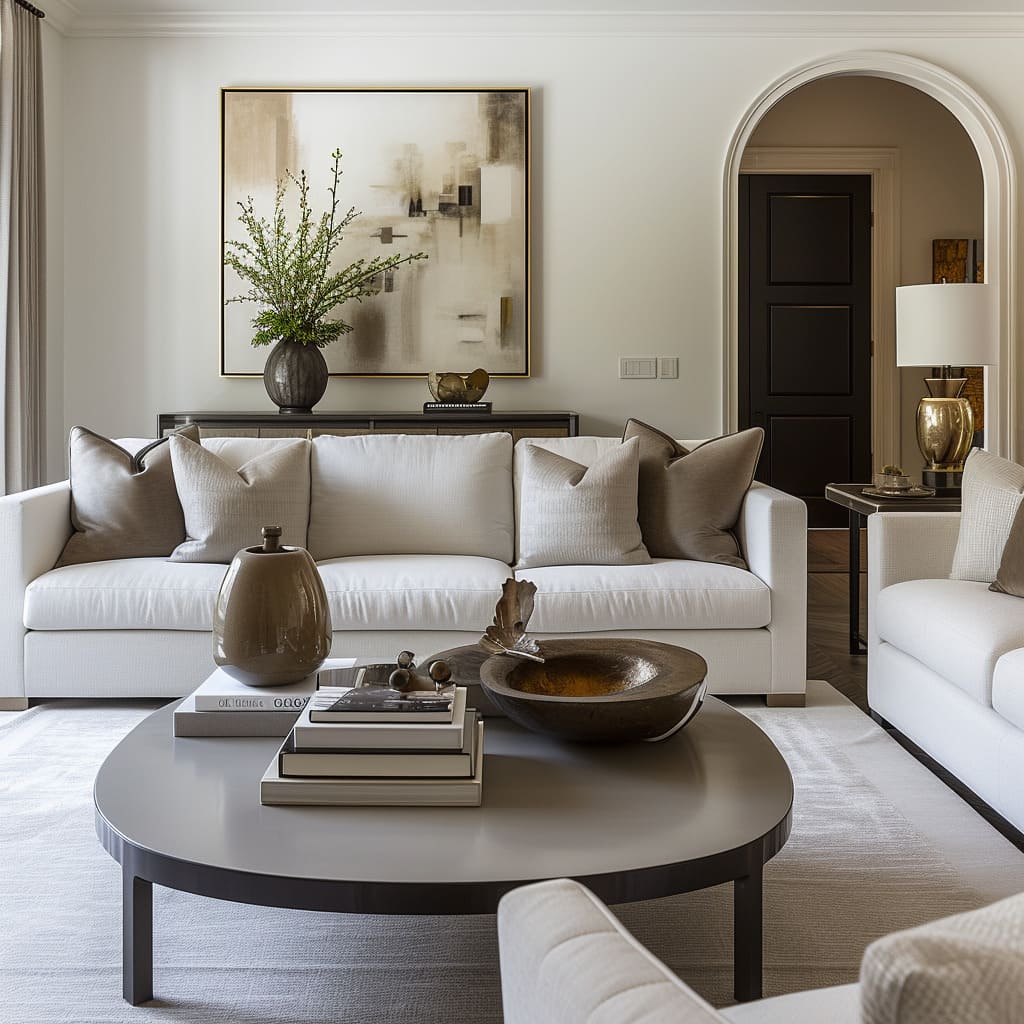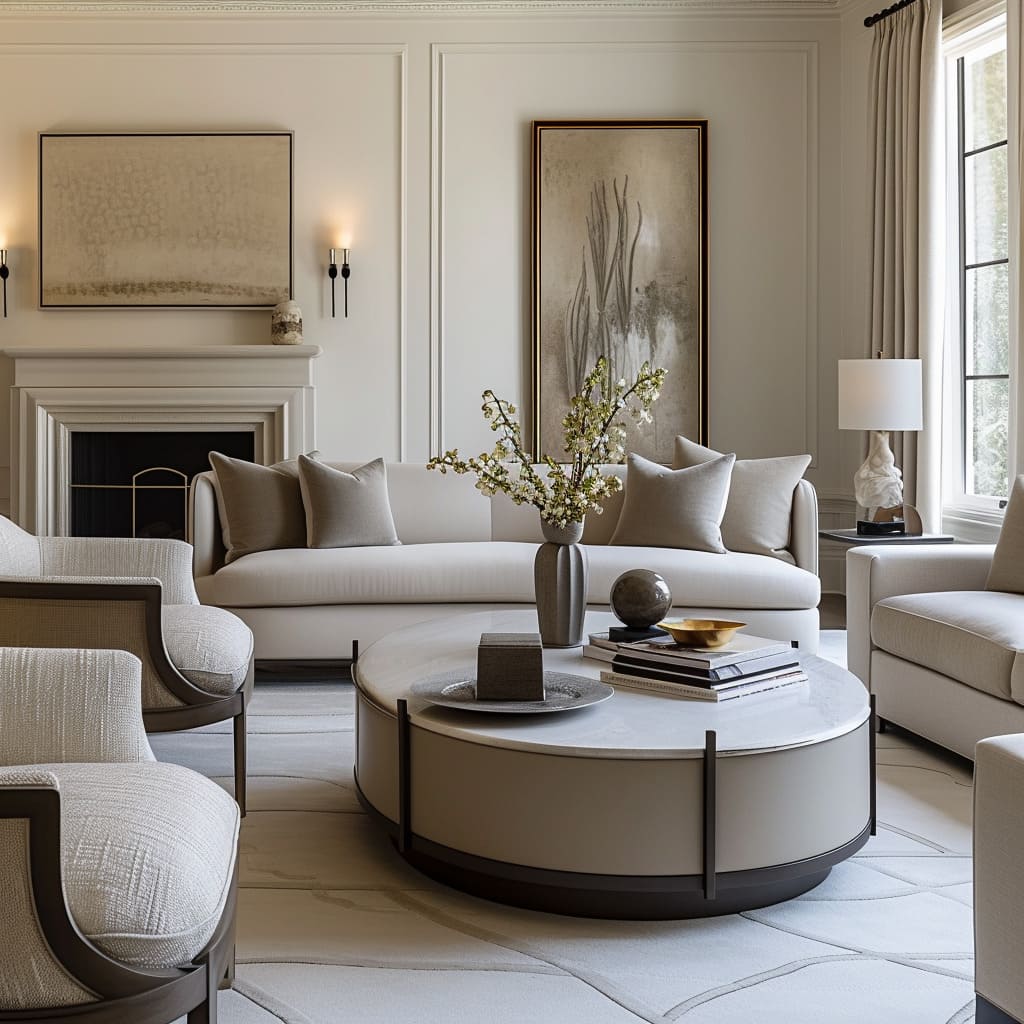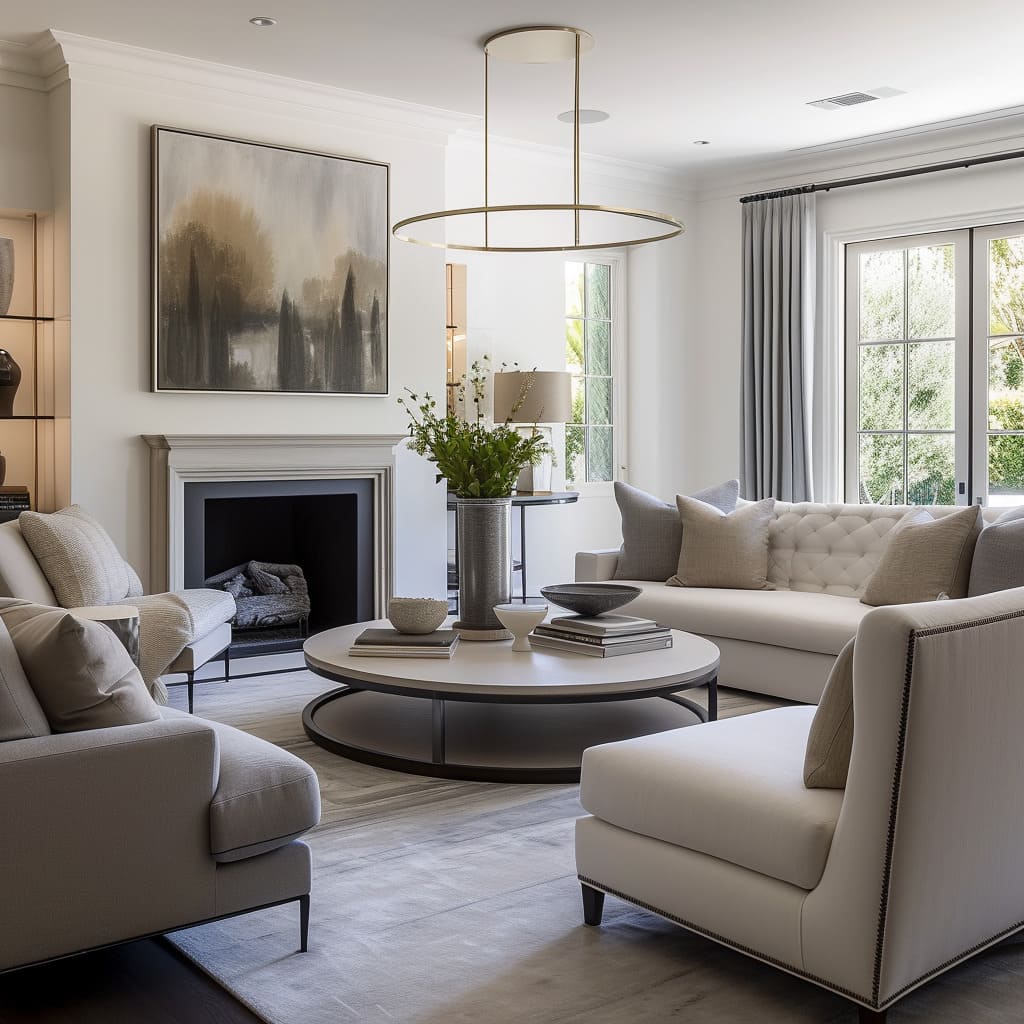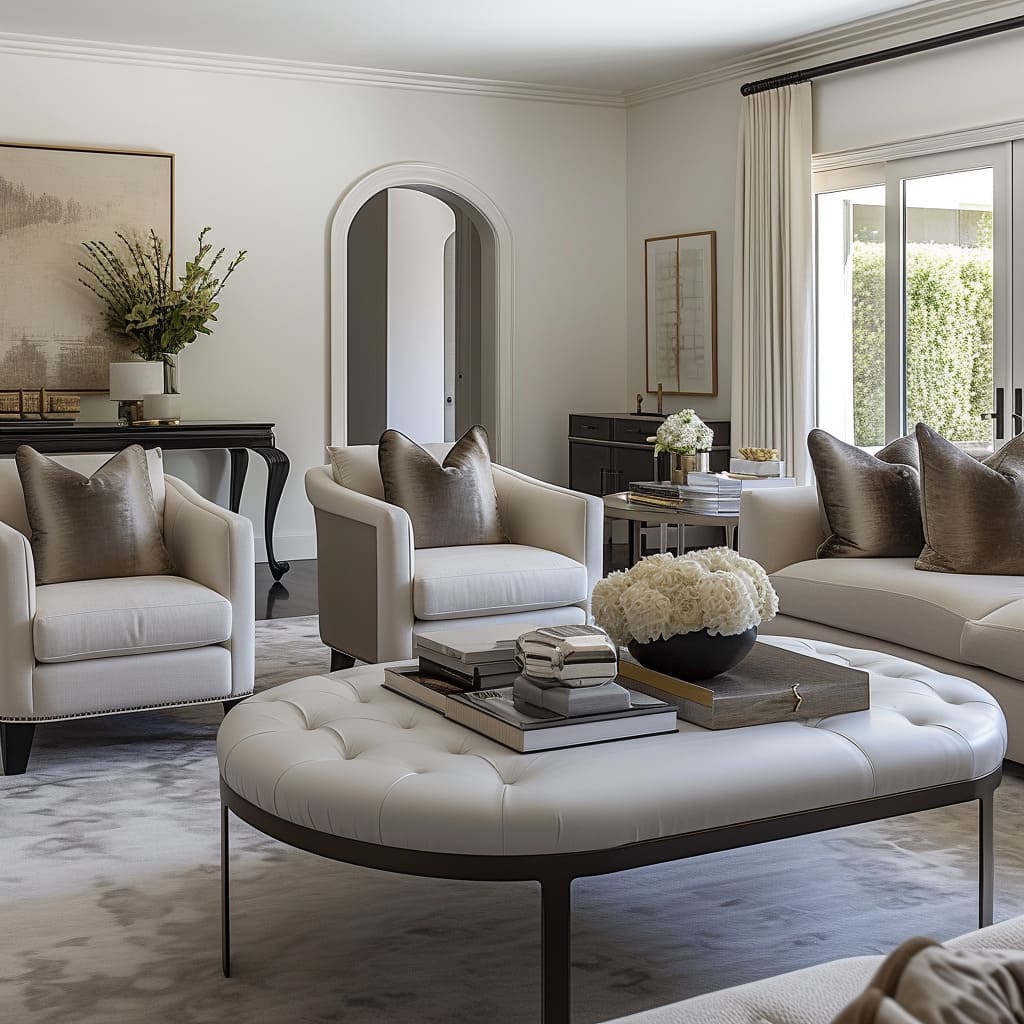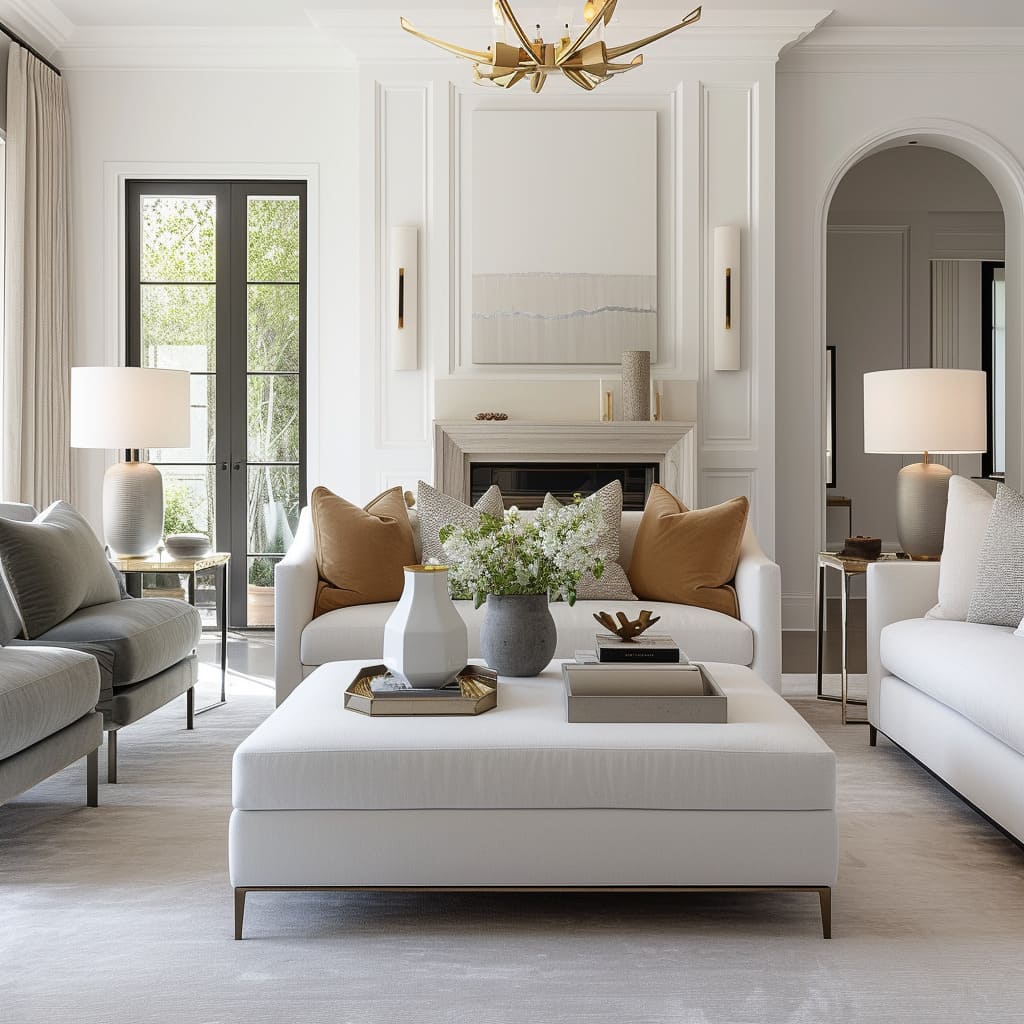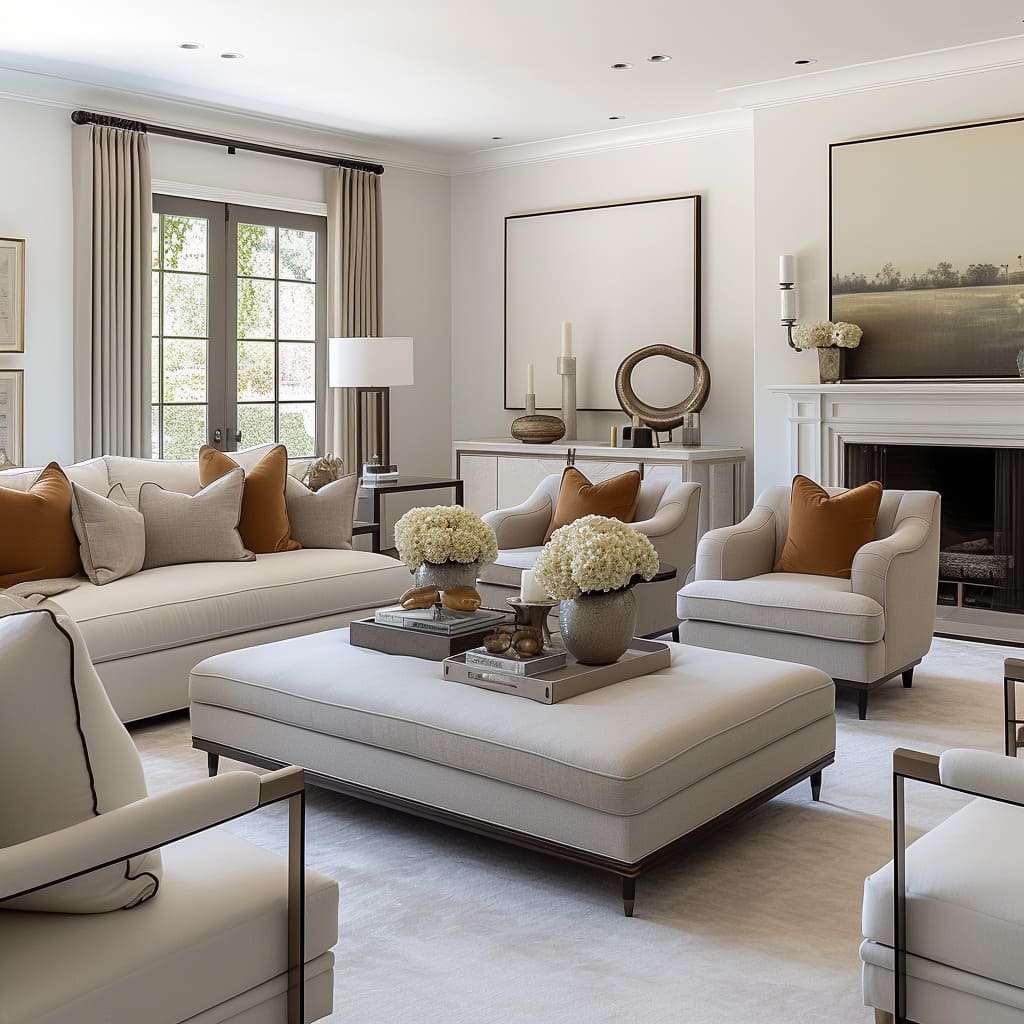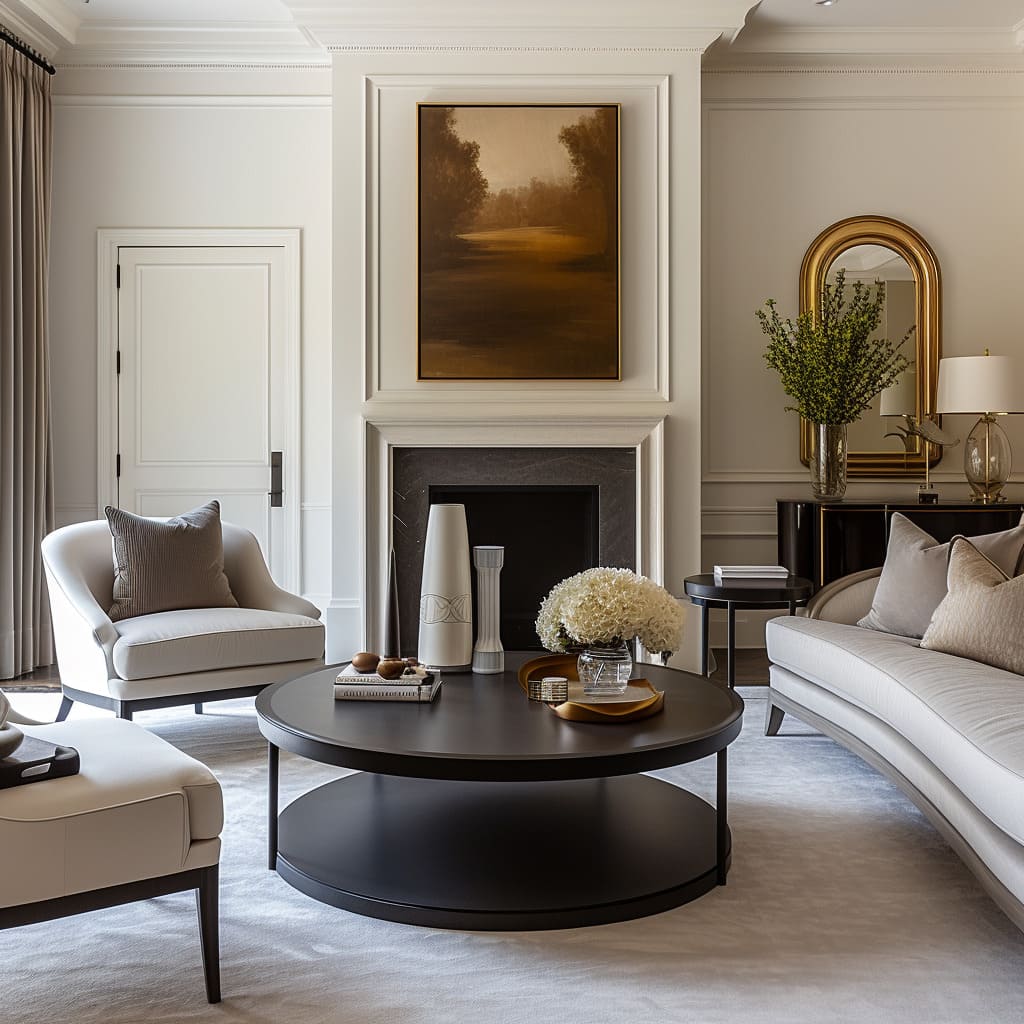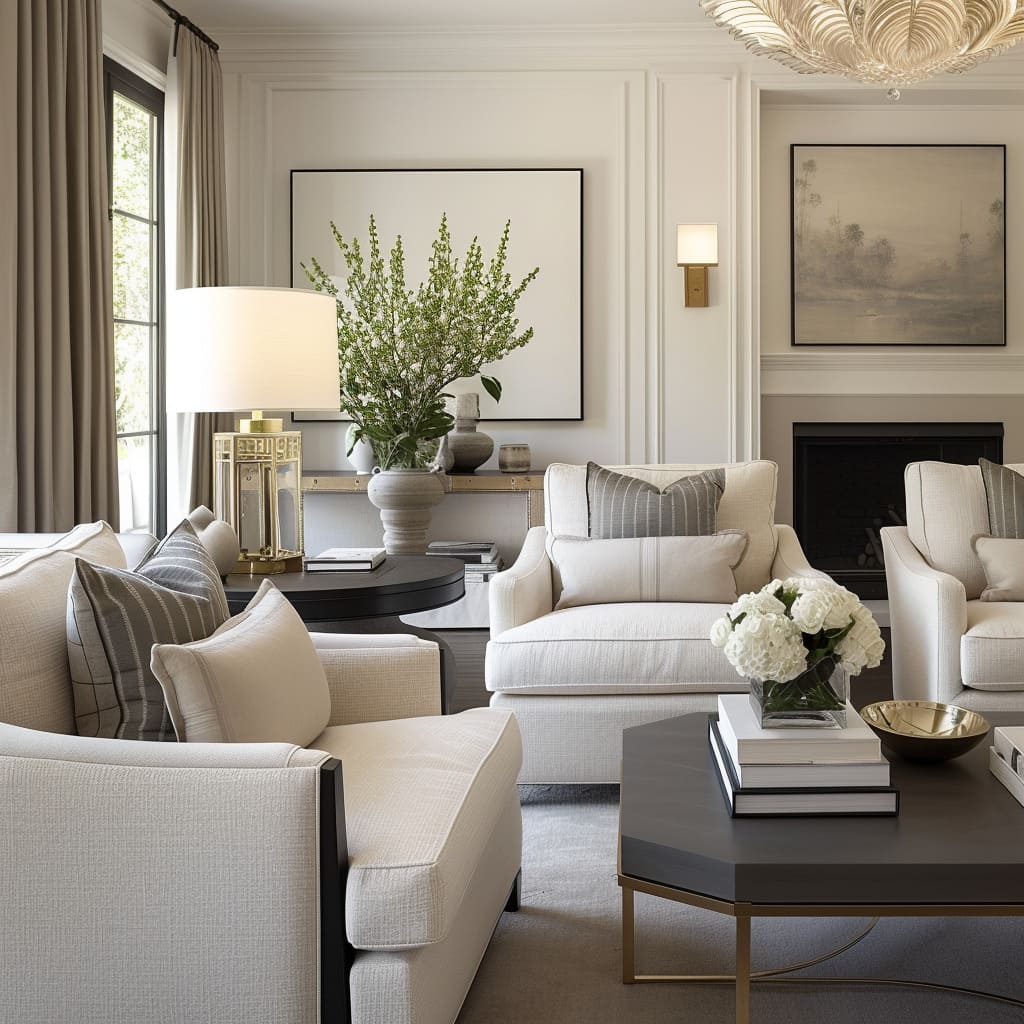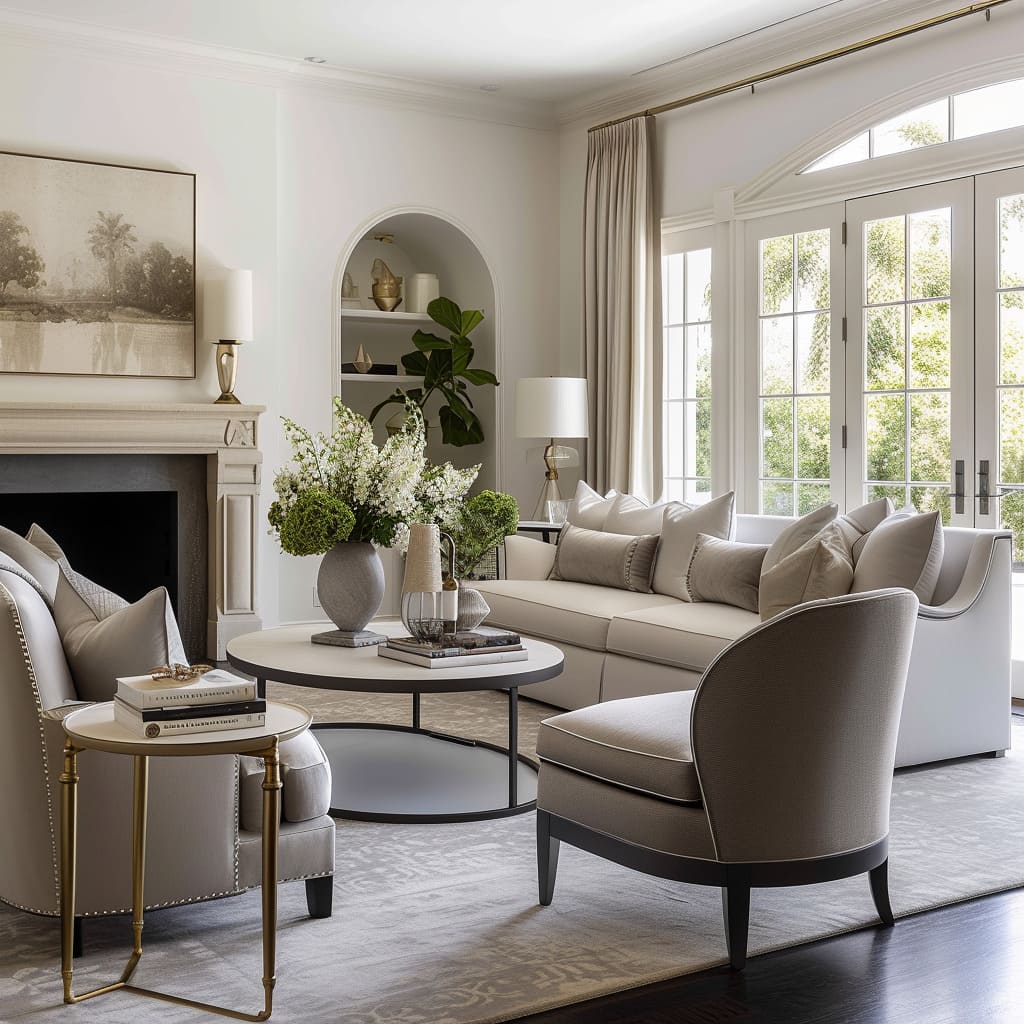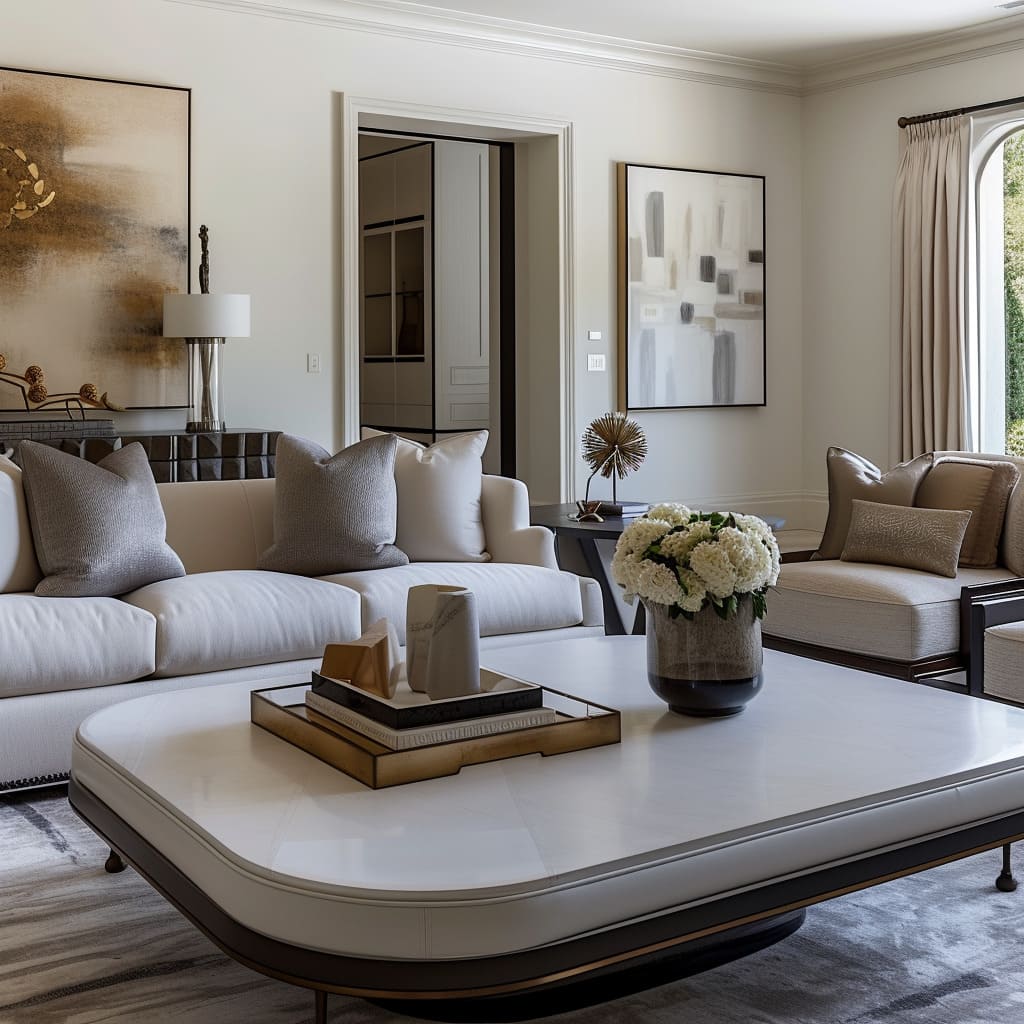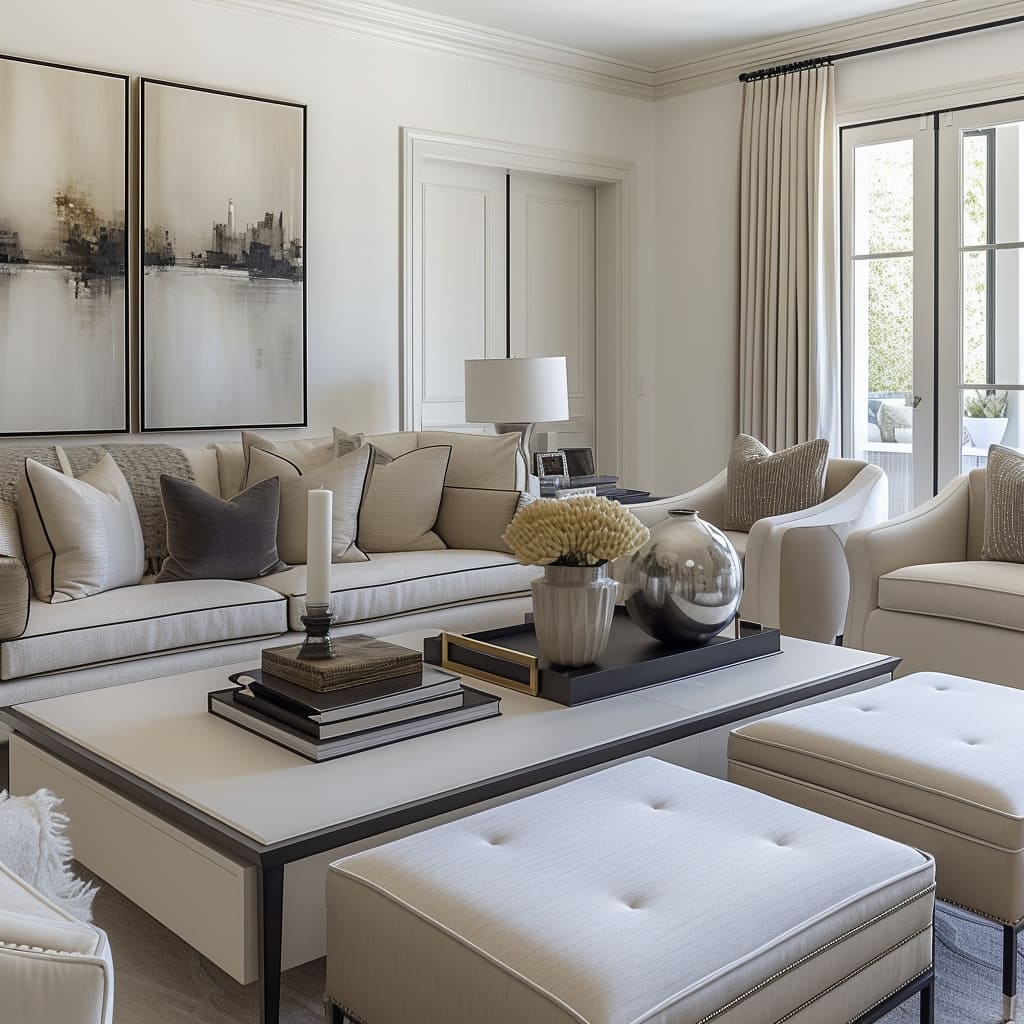Transitional interior design is an elegant and timeless style that integrates the comfort and warmth of traditional design with the clean profiles and understated colors of contemporary style. The hallmark of Transitional design is balance, achieved through a harmonious blend of these two diverse styles.
This balance is evident in various aspects of the interiors, including color palettes, furniture, and décor.
Color Balance: Crafting a Chromatic Harmony
Transitional spaces often feature a neutral color scheme that creates a calm and relaxing backdrop. Tones of beige, ivory, taupe, and gray are predominant, providing a canvas that is both sophisticated and versatile.
These hues are selected for their ability to bridge the gap between stark modern whites and the deeper shades characteristic of traditional design. In these spaces, color is used strategically to add depth, dimension, and a sense of harmony without overwhelming the senses.
The neutral palette is enriched with textures and subtle patterns that add complexity and interest. For instance, a beige sofa is complemented by throw pillows in various shades of gray with different textures.
Wall art, too, often in muted tones, features abstract landscapes that contribute both serenity and a touch of color depth to the room. The artwork serves as a focal point without stark contrast, maintaining the tranquil ambiance of the space.
To further this balanced approach in your own space, consider incorporating different shades within the same color family. For example, a lighter gray wall can be paired with a darker gray or taupe couch.
Add visual interest through the use of textured fabrics like velvet or chenille, which provide a tactile quality that enhances the room’s depth. Area rugs with subtle patterns can anchor the space and add a layer of richness, while still adhering to the neutral color scheme.
For those looking to implement this balance of color in their own interiors, it’s advisable to start with a base of neutral wall colors. From there, build layers with different shades and textures through larger furniture pieces and then accent with even darker or contrasting tones in accessories and artwork.
This layering effect creates a complex but harmonious visual interest that is the essence of Transitional style. It’s important to note that balance doesn’t mean uniformity.
The effective use of contrast can highlight architectural features and define spaces within the room. For example, a dark wooden table against a light gray rug draws the eye and can serve as a gathering point within the space.
Thus, by thoughtfully planning your color scheme, you can achieve a balanced, inviting, and aesthetically pleasing Transitional space.
Furniture Balance: Blending Old and New
In Transitional interiors, furniture often features classic lines with a contemporary twist. The silhouettes are simple yet sophisticated, avoiding the ornate detailing of traditional styles and the extreme minimalism of modern design.
There is a focus on comfort and functionality, with pieces that are scaled to the room to create a sense of proportion. Upholstered pieces in rich textiles provide a sense of luxury without opulence, while wood furniture is often finished in darker tones to ground the space and add warmth.
We observe a deliberate use of plush seating to invite relaxation, with couches and armchairs that boast generous cushioning and soft, rounded edges that soften the geometric lines typical of contemporary furniture. The balance is further manifested in the way furniture groupings are created to foster conviviality while allowing for individual space, indicating a thoughtful consideration of both form and function.
To achieve such balance in furniture within your own space, consider starting with a statement piece, like a sofa or a dining set, that ties the room together. Choose neutral upholstery that complements the walls and flooring but feel free to incorporate accent chairs with bolder shapes or fabrics to add a modern edge.
The key is to mix rather than match, allowing for a nuanced interior that feels curated over time.
Incorporating furniture with dual purposes can also contribute to the balanced Transitional style. For instance, an ottoman can serve both as a visual anchor in the center of a seating area and as additional seating or a place to rest a tray for entertaining.
The use of such versatile pieces maintains the functionality demanded by modern design while respecting the formality of traditional aesthetics.
When arranging the furniture, symmetry plays a crucial role in achieving a balanced look. Pairs of lamps, mirrors, or side tables placed at equal distance introduce a formal equilibrium that is pleasing to the eye.
However, symmetry should not be rigid; the Transitional style allows for subtle breaks in symmetry that add interest and a sense of modernity to the space. In a Transitional space, every piece of furniture should feel intentional, as if it has been hand-selected to balance the room’s overall aesthetic.
Remember that Transitional design is about harmony and proportion. It’s not just about the individual pieces themselves but also about the space between them, allowing each item to breathe and contribute to the room’s collective beauty.
Decor Balance: The Art of Subtle Embellishments
Accessories in Transitional design play a key role in achieving balance. Decorative elements are used sparingly, with an emphasis on quality over quantity.
Artwork tends to be abstract or features landscapes in muted tones that complement the neutral color scheme. Lighting fixtures, while functional, are also chosen for their aesthetic appeal, with designs that blend modern shapes with traditional materials.
Decorative pillows, vases, and throw blankets are chosen for their textural qualities and subtle color variations, adding layers of interest to the space.
One can note the strategic placement of decor that serves to draw the eye without creating clutter. The selection of ornaments is purposeful, often in groups of three to create visual harmony and maintain balance within the space.
This can be seen where table surfaces host trios of decorative items, each varying in height and volume, yet united in style and color palette to produce a cohesive look.
To implement a sense of decor balance in your own space, consider the rule of threes and the principle of odd numbers which are more pleasing to the eye. An arrangement of vases or candles of different heights can create interest and draw attention without overwhelming.
This can also apply to the grouping of pillows on a couch or objects on a bookshelf. The key is cohesion and restraint to maintain a tranquil and elegant atmosphere characteristic of Transitional design.
Artwork is carefully curated to reflect the understated elegance of Transitional interiors. A large, framed abstract piece in subdued tones or a classic black and white photograph can serve as a central focal point, while smaller pieces can be used to fill spaces without causing visual noise.
Art should complement the space, not compete with it. Choose pieces that speak to you personally, but keep in mind the overall color scheme and atmosphere you wish to achieve.
In lighting, the interiors showcase fixtures that blend function with style—sleek floor lamps with metallic finishes, understated chandelier pieces with clean lines, and table lamps with ceramic or glass bases that reflect light and add a subtle sparkle to the room. In a Transitional design, lighting is not just a utility but a key element that can enhance the ambiance and draw attention to other design features.
When considering how to balance decor in your own transitional interiors, remember that each piece should contribute to the room’s narrative. A balanced approach would be to select accessories that have a consistent theme or material, such as glass, wood, or metal, and disperse them throughout the space to create a sense of unity.
The textures of the decor elements should also play off one another—smooth against rough, matte against shine—to create a sensory balance that is as tactile as it is visual.
Balance in Layout and Composition: Orchestrating Furniture and Flow
Transitional design also pays attention to the balance of the layout. Furniture is arranged to encourage conversation and interaction, while also allowing for ease of movement.
There is a symmetry and alignment in the placement of furniture and décor, creating a sense of order and calm. Rugs are used to define seating areas, while also adding texture and warmth to the hardwood or tile flooring typical of this style.
The layouts exemplify this balance through the purposeful use of space. Each furniture piece is positioned to maintain an open and inviting atmosphere.
Seating is often arranged in a face-to-face fashion, promoting engagement among inhabitants and guests. The placement of chairs and sofas in relation to coffee tables and side tables allows for both accessibility and comfort, ensuring that the environment supports both the practical and aesthetic needs of the space.
To realize a balanced layout in your own interior, it’s important to consider both the scale of furniture and its placement in the room. Begin by selecting key pieces that fit the size of the space without overwhelming it.
Then, arrange these pieces to create distinct zones for different activities, such as a reading nook or a social seating area. The flow between these areas should feel natural, with open pathways that facilitate movement throughout the room.
The strategic use of rugs emphasizes distinct areas within the larger space, providing a visual anchor for the furniture. The rugs’ placement and size are key; they are large enough to sit under all the primary furniture of a seating arrangement, which helps to unify the group of pieces and delineates the space without the use of walls or dividers.
Rugs also introduce an additional layer of texture and can add subtle color or pattern to the room.
In creating a balanced composition, one must also consider the visual weight of the room. The designs show how darker, heavier pieces are balanced with lighter, airier elements.
For example, a robust coffee table might be offset by a delicate floor lamp or slender-legged chairs. This creates a dynamic tension that is visually interesting yet still harmonious.
Symmetry is a common tactic in achieving balance in Transitional interiors. However, it’s not about perfect mirroring; instead, it’s about balancing the visual weight across the space.
For example, a pair of armchairs might flank a fireplace, while a single large sofa faces it. The key is to distribute the visual weight evenly so that no one side of the room feels heavier or more cluttered than the other.
When attempting to achieve balance in your layout, remember that flexibility and adaptability are crucial. Transitional design is not static; it should evolve with your lifestyle.
Incorporate pieces that can be easily moved or repurposed as your needs change. This might include lightweight side tables, ottomans on casters, or modular pieces that can be reconfigured.
By maintaining a flexible approach to layout and composition, your space can remain balanced and beautiful for years to come.
Balancing Light and Space: The Dance of Light and Volume
The use of light and space is carefully considered to create a balanced environment. Windows are often dressed with sheer curtains that allow natural light to filter through, enhancing the sense of openness and airiness.
In contrast, heavier drapes can be used to frame the windows and provide a touch of traditional elegance. Mirrors and reflective surfaces are strategically placed to maximize light and create the illusion of a larger space.
The interplay between light and space is evident in the careful positioning of windows and the selection of window treatments. Sheer curtains not only allow for diffused lighting but also connect the indoors with the outdoors, making the space feel larger and more open.
The use of mirrors is particularly noticeable, with their placements not just for function but to visually expand the space and reflect both natural and artificial light, enhancing the room’s luminosity at all times of the day.
To infuse your own space with a balanced light and spatial design, consider the orientation of the room and the natural light available. Use light-filtering window treatments to maximize daylight and layer with opaque drapes for privacy and light control.
Consider the shape and placement of mirrors to reflect light into darker corners or to reflect a beautiful view, effectively doubling the visual space.
The balance can also be achieved through the use of artificial lighting. The living rooms show a variety of lighting types, from overhead fixtures to table lamps, which work together to create a layered lighting scheme.
This allows for flexibility, providing bright light for functionality or dimmer, ambient light for a cozier atmosphere. The use of dimmer switches can also provide control over the intensity of light, adapting to different times of the day and different needs.
The spaces are meticulously planned to avoid crowding while still feeling complete. Furniture is arranged to allow for unobstructed pathways, and decor is scaled to the size of the room.
This careful spatial planning helps to maintain a sense of balance and flow that is not only visually pleasing but also practical. When considering how to achieve this balance in your own home, it’s important to think about the use of both positive and negative space.
Allow for areas of rest within the design, such as clear tabletops or open wall spaces, which give the eye a place to rest and prevent the environment from feeling cluttered. Balance can be found in the equilibrium between the occupied and the vacant, the light and the shadow, the full and the empty.
The ultimate goal in balancing light and space in Transitional design is to create a serene and hospitable environment. This balance ensures the room feels cohesive and grounded yet dynamic and alive.
By considering both the quality of light and the arrangement of space, you can craft an interior that is both functional and aesthetically pleasing, a true haven of balanced design.
Integration of Elements: Melding Diverse Textures and Times
What sets Transitional design apart is its ability to seamlessly integrate elements from different time periods and styles without allowing one to overpower the other. This balanced approach extends to textures and materials, with a mix of metal, glass, wood, and fabric that feels curated and cohesive.
This blend of materials and textures is evident, where sleek metal finishes on lamp bases and hardware are paired with the warmth of polished wood tables and plush fabrics on upholstery. The interplay of reflective and matte surfaces creates a dialogue between elements that might otherwise be at odds, lending a subtle complexity to the space that is a hallmark of Transitional style.
To create this sense of integration in your own space, consider each piece’s material and finish. Combine glass or metal accent pieces with a wooden coffee table or bookshelf.
Look for opportunities to mix metals, such as brass and iron or silver and gold, in a way that feels intentional but not matchy-matchy. The goal is to curate a collection of materials that reflect a range of styles, resulting in a rich and nuanced design.
One can also notice a thoughtful approach to fabric choices. There is a variety of textures, from the smooth, clean lines of leather to the softness of woven textiles.
This variety adds depth and interest to the interiors, inviting touch and interaction. The fabrics not only serve a functional purpose but also contribute to the layered aesthetic of Transitional design.
Recommendations for realizing this feature in an interior include being deliberate with the juxtaposition of elements. For example, place a modern glass vase on an antique wooden table, or pair a traditional, ornate mirror with a sleek, contemporary console.
The contrast of these elements should feel harmonious, not jarring, united by a common color scheme or shared geometric shape.
The balance is also achieved through proportion and scale. Larger furniture pieces are balanced by smaller, more delicate accessories.
A bulky sofa is complemented by a dainty side table, or a robust dining table is surrounded by slender, elegant chairs. This careful balance of scale ensures that the room feels both grounded and spacious, with each element given space to stand out without crowding the others.
As you integrate various elements into your Transitional interior, aim for a sense of equilibrium between the old and the new, the bold and the understated, the organic and the engineered. It is this equilibrium that creates the serene and timeless quality of Transitional design, making it adaptable and enduringly stylish.
In summary, the essence of Transitional style lies in its balanced approach to design. It carefully walks the line between traditional comfort and contemporary simplicity, resulting in spaces that are both timeless and modern.
By blending the best elements of each style, it creates interiors that are not just visually appealing but also deeply comfortable and inviting.


